Numerical Simulation of Two-Stage Variable Geometry Turbine
Abstract
1. Introduction
2. Design of Turbine Wheel
3. Model Preparation
4. Numerical Domain
5. Simulation
5.1. Mesh Independence Study
5.2. Simulation for Three Revolutions of the Crankshaft
5.3. Validation
6. Results and Discussion
6.1. Flow Parameter of the 1st Stage Nozzle Vane
6.2. Flow at the VTG Nozzle Vanes
7. Conclusions
Author Contributions
Funding
Institutional Review Board Statement
Informed Consent Statement
Data Availability Statement
Acknowledgments
Conflicts of Interest
Nomenclature
| Notations | |||
| w | Relative velocity | M | The Mach number |
| c | Absolute velocity | Tip leakage loss factor | |
| u | Linear velocity | The vane outlet deviation angle | |
| Absolute velocity angle | t | Distance between the vane trailing edges | |
| Relative velocity angle | a | The speed of sound | |
| p | Static pressure | Blade relative angle | |
| Total pressure | |||
| Total temperature | |||
| ϕ | Vane flow coefficient | ||
| k′ | Exhaust specific heat ratio | ||
| R′ | Exhaust gas constant | ||
| Turbine isentropic enthalpy drop | |||
| Total enthalpy | |||
| ρ | The turbine reaction ratio | ||
| The rotor expansion work | |||
| The rotor expansion efficiency | |||
| The turbine expansion work | |||
| The turbine efficiency | |||
| The turbine mechanical efficiency | |||
| D | Diameter of the turbine | ||
| n | The rotational speed of the turbine | ||
| s | Perpendicular vane distance | ||
| Subscripts | Abbreviations | ||
| 0 | Conditions before first-stage nozzle vanes | ICE | Internal combustion engine |
| 1 | Conditions after first-stage nozzle vanes | 3-D | Three-dimensional |
| 2 | Conditions after first-stage rotor | OP | Opposed piston (engine) |
| 3 | Conditions before second-stage rotor | TE | Trailing edge |
| 4 | Conditions after second-stage rotor | SA | Spalart-Allmaras turbulence model |
| 5 | Conditions at the outlet | CAD | Crank angle degree |
| D | Stator vane conditions | VTG | Variable Turbine Geometry |
| W | Rotor conditions | RMSE | Root mean square error |
| iz | Isentropic parameters | ||
References
- Thomas, A.; Samuel, J.; Ramesh, A. Mean-Line Modelling of a Variable Geometry Turbocharger (VGT) and Prediction of the Engine-Turbocharger Coupled Performance. In Proceedings of the ASME 2017 Gas Turbine India Conference, Bangalore, India, 7–8 December 2017. [Google Scholar]
- Erik, T.; Flora, C.; Maria, R.J.; Igor, I. Fully Automated Multidisciplinary Design Optimization of a Variable Speed Turbine. In Proceedings of the 30th IAHR Symposium on Hydraulic Machinery and Systems (IAHR 2020), Lausanne, Switzerland, 21–26 March 2020. [Google Scholar]
- Ponsankar, S.; Bikram, R.; Anshul, T. Turbocharger Lag Mitigation System. In Proceedings of the International Conference on Advances in Renewable and Sustainable Energy Systems (ICARSES 2020), Chennai, India, 3–5 December 2020. [Google Scholar]
- Tong, Z.; Cheng, Z.; Tong, S. Preliminary Design of Multistage Radial Turbines Based on Rotor Loss Characteristics under Variable Operating Conditions. Energies 2019, 12, 2550. [Google Scholar] [CrossRef]
- Lauriau, P.T.; Binder, N.; Cros, S.; Roumeas, M.; Carbonneau, X. Preliminary Design Considerations for Variable Geometry Radial Turbines with Multi-Points Specifications. Int. J. Turbomach. Propuls. Power 2018, 3, 22. [Google Scholar] [CrossRef]
- Panneerselvam, S.; Vijayaragavan, M. Performance Analysis of Variable Geometry Turbocharged CI Engine. In Proceedings of the 2nd International conference on Advances in Mechanical Engineering (ICAME 2018), Kattankulathur, India, 22–24 March 2018. [Google Scholar]
- Zamboni, G. A Study on Combustion Parameters in an Automotive Turbocharged Diesel Engine. Energies 2018, 11, 2531. [Google Scholar] [CrossRef]
- Zamboni, G.; Moggia, S.; Capobianco, M. Effects of a Dual-Loop Exhaust Gas Recirculation System and Variable Nozzle Turbine Control on the Operating Parameters of an Automotive Diesel Engine. Energies 2017, 10, 47. [Google Scholar] [CrossRef]
- Binder, N.; Le Guyader, S.; Carbonneau, X. Analysis of the Variable Geometry Effect in Radial Turbines. ASME J. Turbomach. 2012, 134, 1–9. [Google Scholar] [CrossRef]
- Ricardo, M.B. Variable Geometry Mixed Flow Turbine for Turbochargers: An Experimental Study. Int. J. Fluid Mach. Syst. 2008, 1, 155–168. [Google Scholar] [CrossRef]
- Wu, C.; Song, K.; Li, S.; Xie, H. Impact of Electrically Assisted Turbocharger on the Intake Oxygen Concentration and Its Disturbance Rejection Control for a Heavy-duty Diesel Engine. Energies 2019, 12, 3014. [Google Scholar] [CrossRef]
- Pesiridis, A.; Saccomanno, A.; Tuccillo, R.; Capobianco, A. Conceptual Design of a Variable Geometry, Axial Flow Turbocharger Turbine. SAE Tech. Paper 2017, 1–16. [Google Scholar] [CrossRef]
- Fayez, S.A.; Salah, L.; Adeel, M.; Mohammed, E.B. Estimation of Exhaust Gas Aerodynamic Force on the Variable Geometry Turbocharger Actuator: 1D Flow Model Approach. Energy Convers. Manag. 2014, 84, 436–447. [Google Scholar] [CrossRef]
- Kumar, P.; Zhang, Y.; Traver, M.; Watson, J. Tailored Air-Handling System Development for Gasoline Compression Ignition in a Heavy-Duty Diesel Engine. Front. Mech. Eng. 2021, 7, 6. [Google Scholar] [CrossRef]
- Thomas, A.; Samuel, J.J.; Pramod, M.P.; Ramesh, A.; Murugesan, R.; Kumarasamy, A. Simulation of a Diesel Engine with Variable Geometry Turbocharger and Parametric Study of Variable Vane Position on Engine Performance. Def. Sci. J. 2017, 67, 375–381. [Google Scholar] [CrossRef][Green Version]
- Vítek, O.; Macek, J.; Polášek, M. New Approach to Turbocharger Optimization using 1-D Simulation Tools. SAE Tech. Paper 2006, 1–17. [Google Scholar] [CrossRef]
- Bharath, A.; Reitz, R.; Rutland, C. Impact of Active Control Turbocharging on the Fuel Economy and Emissions of a Light-Duty Reactivity Controlled Compression Ignition Engine: A Simulation Study. Front. Mech. Eng. 2021, 7, 8. [Google Scholar] [CrossRef]
- Hu, B.; Li, J.; Li, S.; Yang, J. A Hybrid End-to-End Control Strategy Combining Dueling Deep Q-network and PID for Transient Boost Control of a Diesel Engine with Variable Geometry Turbocharger and Cooled EGR. Energies 2019, 12, 3739. [Google Scholar] [CrossRef]
- Hu, B.; Yang, J.; Li, J.; Li, S.; Bai, H. Intelligent Control Strategy for Transient Response of a Variable Geometry Turbocharger System Based on Deep Reinforcement Learning. Processes 2019, 7, 601. [Google Scholar] [CrossRef]
- Mirza, H.D.; Heath, W.P.; Apsley, J.M.; Forbes, J.R. Down-Speeding Diesel Engines with Two-Stage Turbochargers: Analysis And Control Considerations. Int. J. Eng. Res. 2020. [Google Scholar] [CrossRef]
- Vincenzo, D.B.; Marelli, S.; Bozza, F.; Capobianco, M. 1D Simulation and Experimental Analysis of a Turbocharger Turbine for Automotive Engines under Steady and Unsteady Flow Conditions. Energy Procedia 2014, 45, 909–918. [Google Scholar] [CrossRef]
- Pesyridis, A.; Vassil, B.; Padzillah, M.H.; Ricardo, M.B. A Comparison of Flow Control Devices for Variable Geometry Turbocharger Application. Int. J. Autom. Eng. Technol. 2014, 3, 1–21. [Google Scholar] [CrossRef][Green Version]
- Nonthakarn, P.; Ekpanyapong, M.; Nontakaew, U.; Bohez, E. Design and Optimization of an Integrated Turbo-Generator and Thermoelectric Generator for Vehicle Exhaust Electrical Energy Recovery. Energies 2019, 12, 3134. [Google Scholar] [CrossRef]
- Osmić, M.; Delic, I. Determination of Flow Field in the Stator of the Variable Turbocharger. Mach. Technol. Mater. 2009, 2, 18–21. [Google Scholar]
- Minasyan, A.; Bradshaw, J.; Pesyridis, A. Design and Performance Evaluation of an Axial Inflow Turbocharger Turbine. Energies 2018, 11, 278. [Google Scholar] [CrossRef]
- Fulara, S.; Chmielewski, M.; Gieras, M. Variable Geometry in Miniature Gas Turbine for Improved Performance and Reduced Environmental Impact. Energies 2020, 13, 5230. [Google Scholar] [CrossRef]
- Lei, H.; Hua, C. A Novel Design Method of Variable Geometry Turbine Nozzles for High Expansion Ratios. In Proceedings of the 17th International Symposium on Transport Phenomena and Dynamics of Rotating Machinery (ISROMAC2017), Maui, HI, USA, 16–21 December 2017. [Google Scholar]
- Liu, J.; Qiao, W.Y.; Duan, W.H. Investigation of Unsteady Aerodynamic Excitation on Rotor Blade of Variable Geometry Turbine. Int. J. Rotating Mach. 2019, 1–13. [Google Scholar] [CrossRef]
- Kozak, D.; Mazuro, P. Transient Simulation of the Six-Inlet, Two-Stage Radial Turbine under Pulse-Flow Conditions. Energies 2021, 14, 2043. [Google Scholar] [CrossRef]
- Spalart, P.; Allmaras, S. A One-Equation Turbulence Model for Aerodynamic Flows. Rech. Aerosp. 1994, 1, 5–21. [Google Scholar]

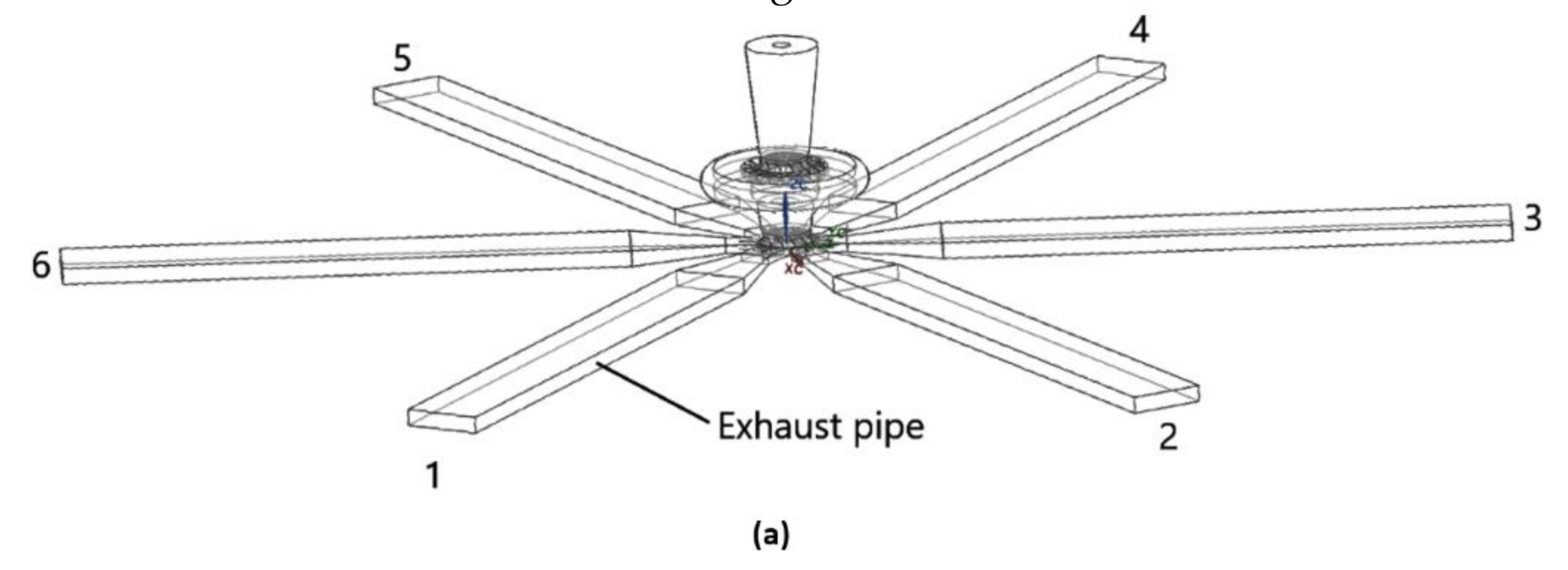
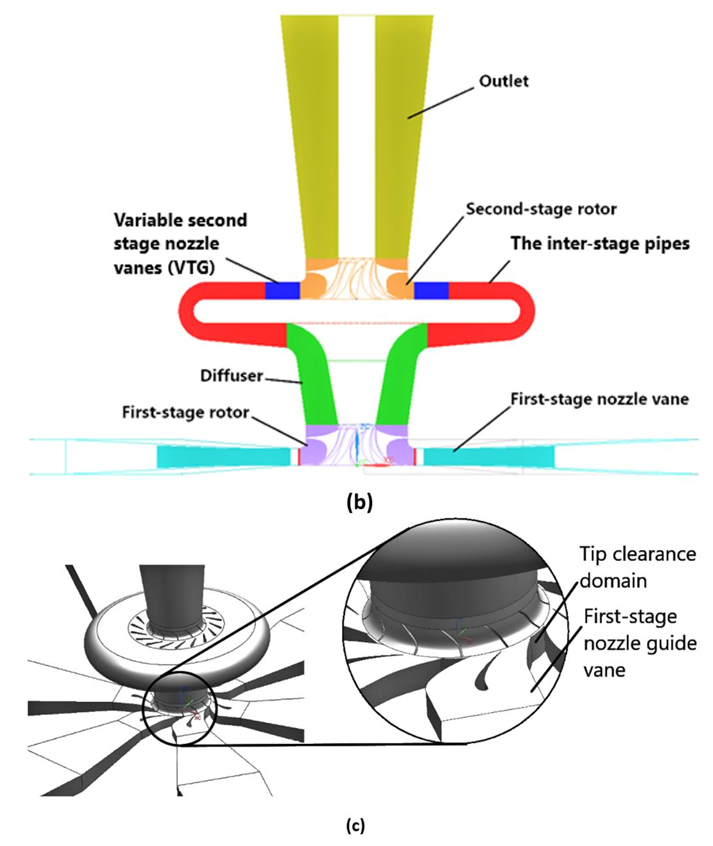
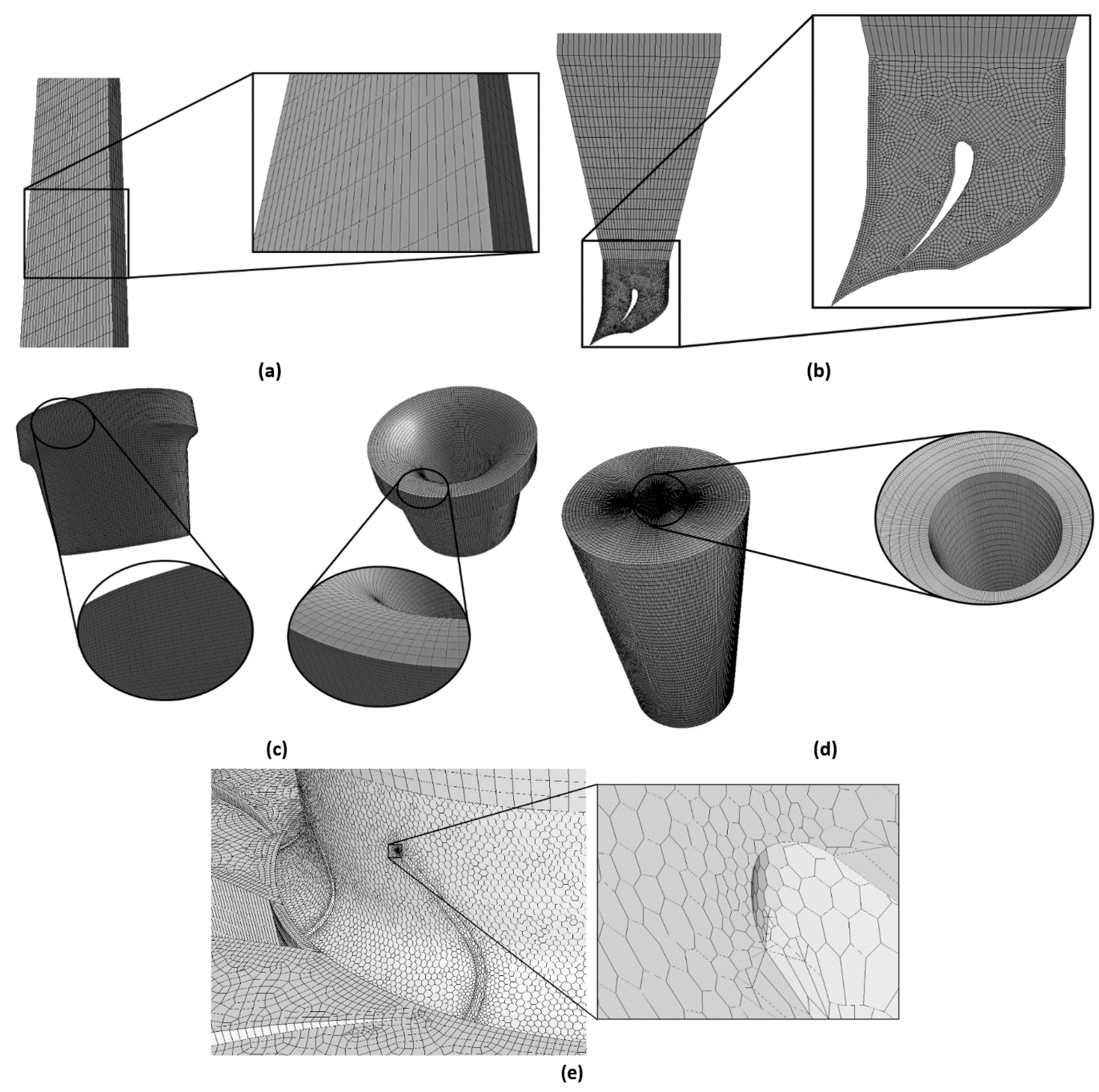
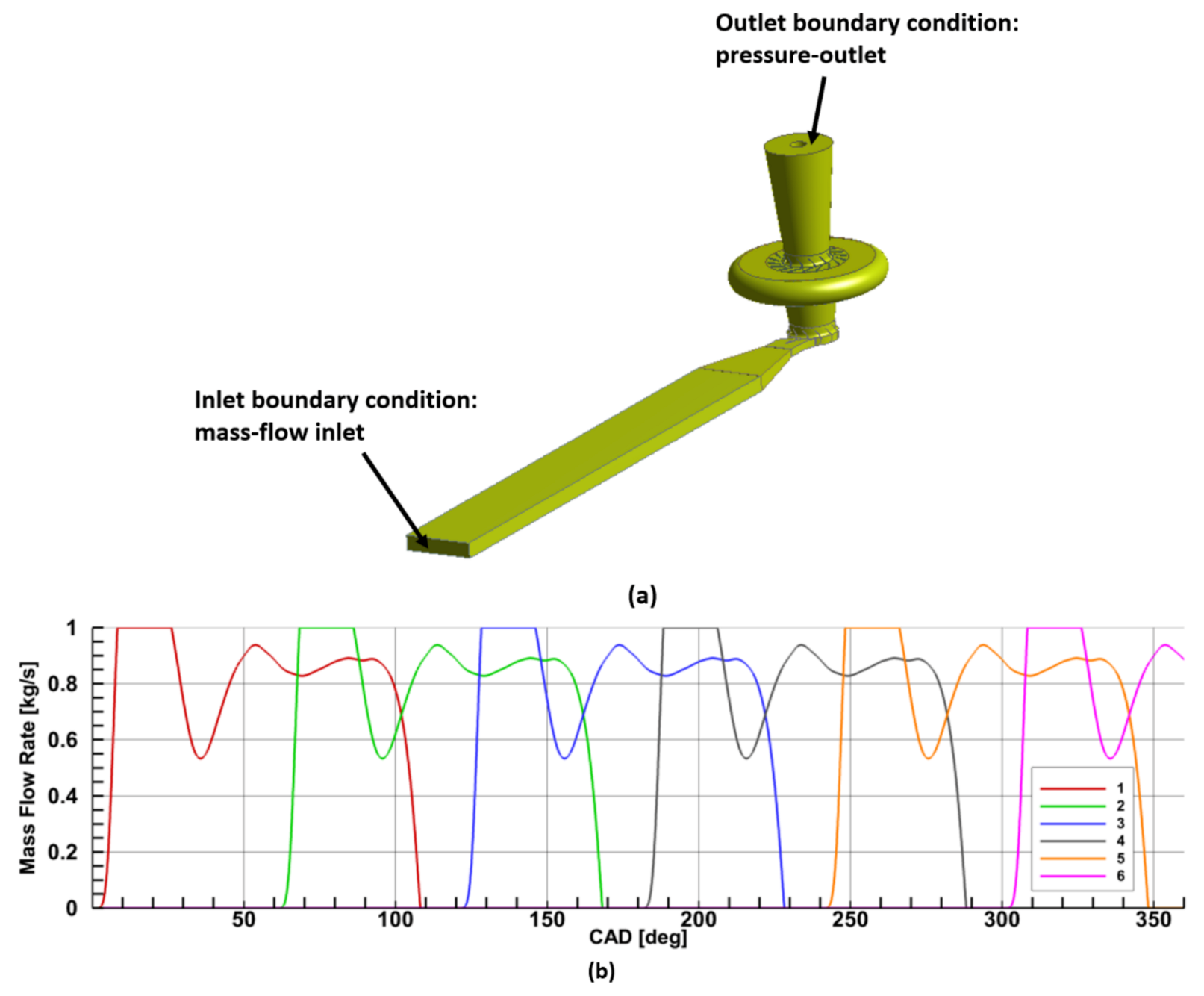
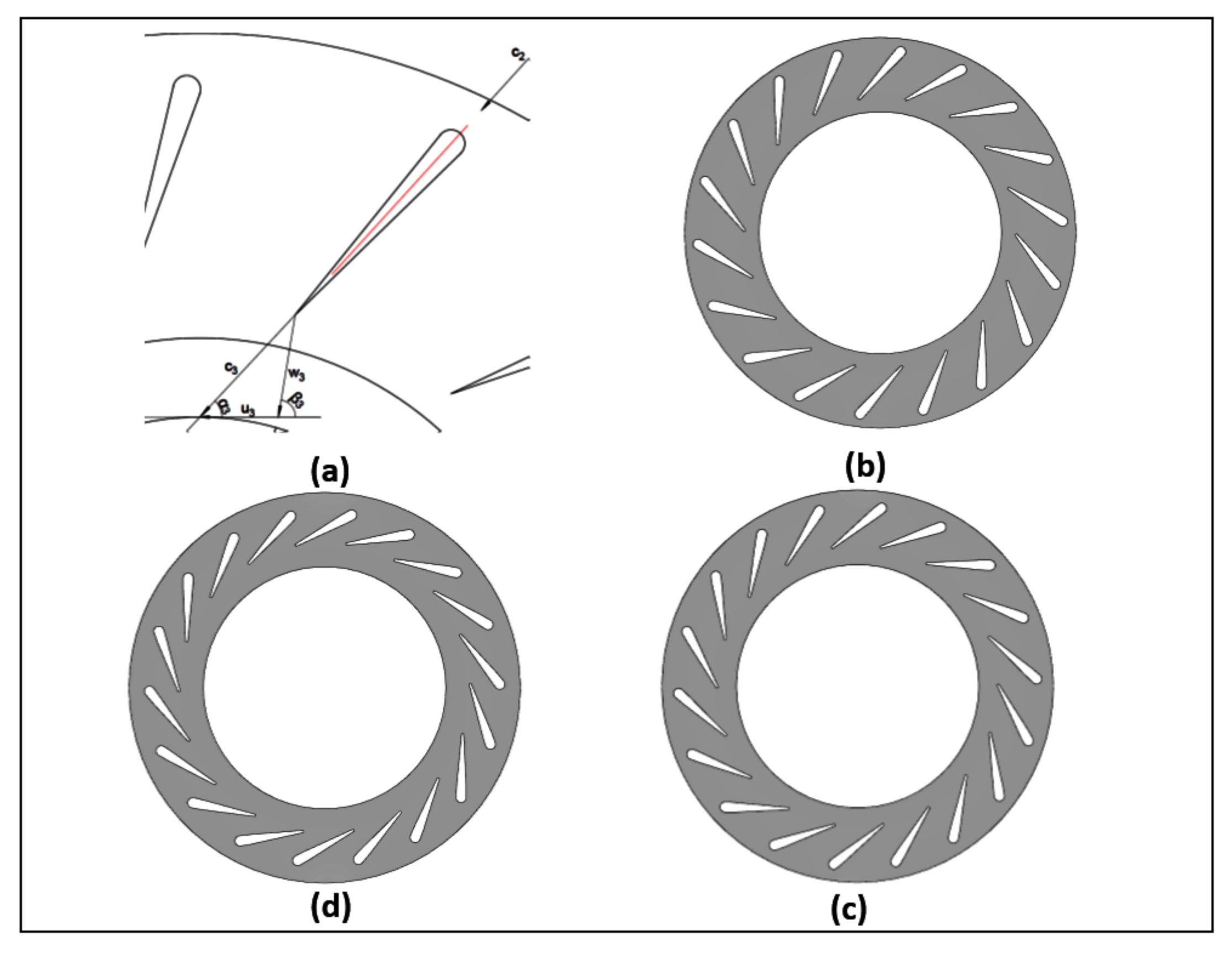
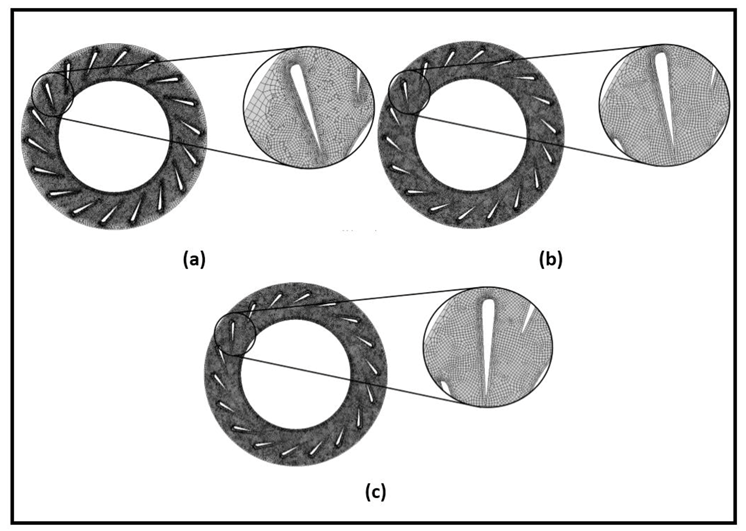
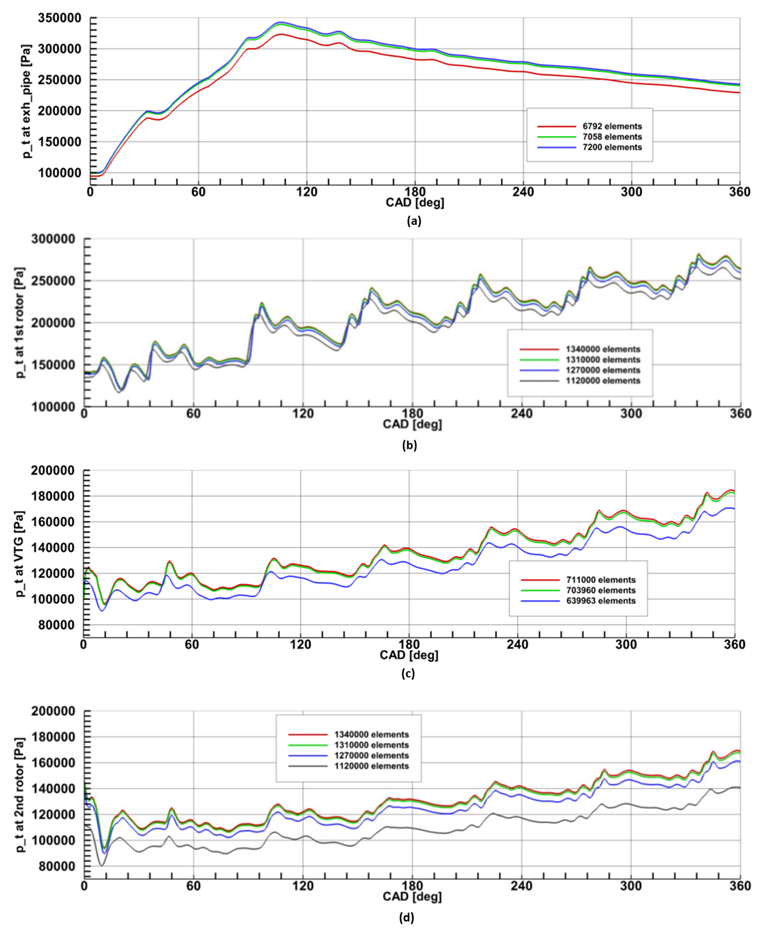

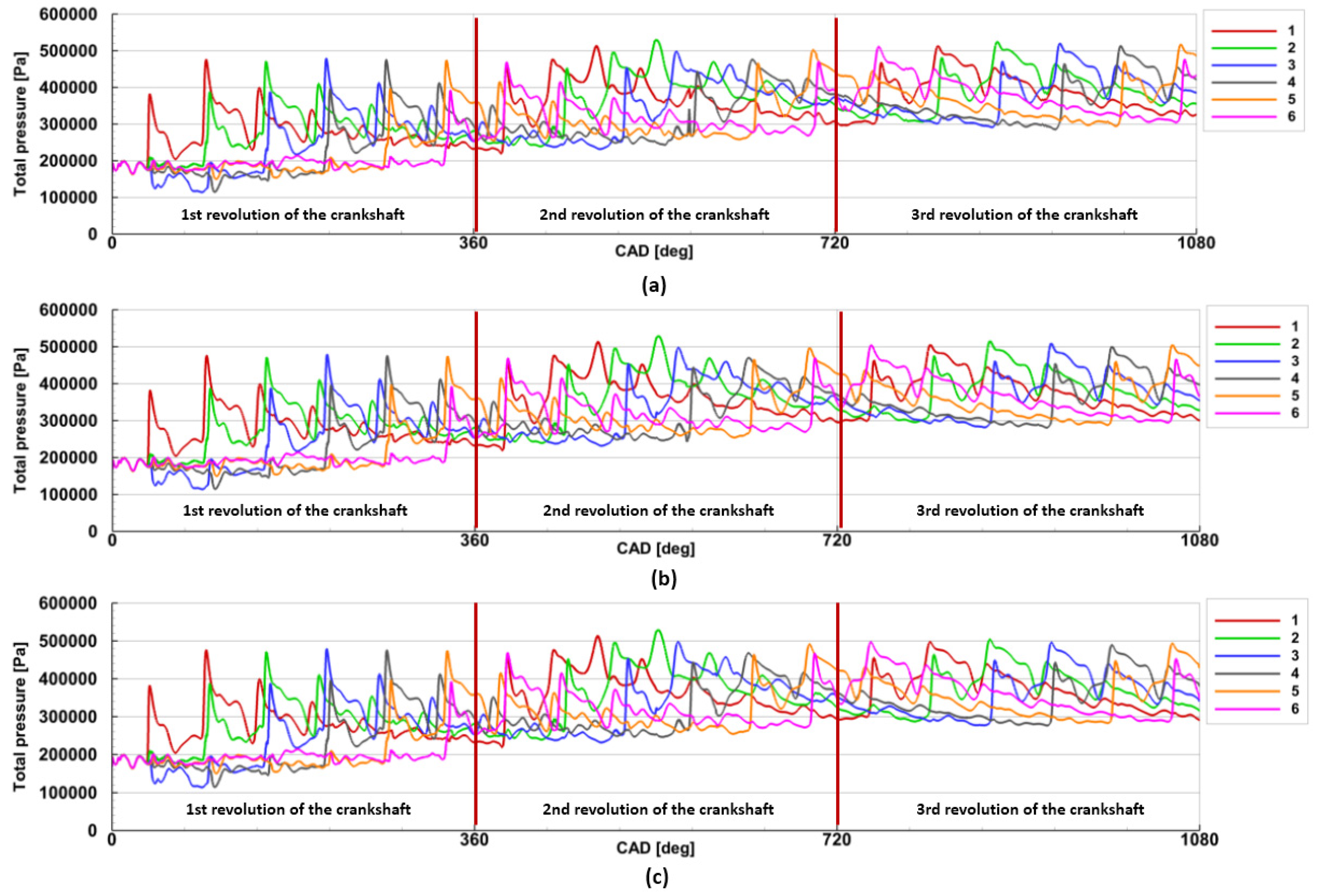
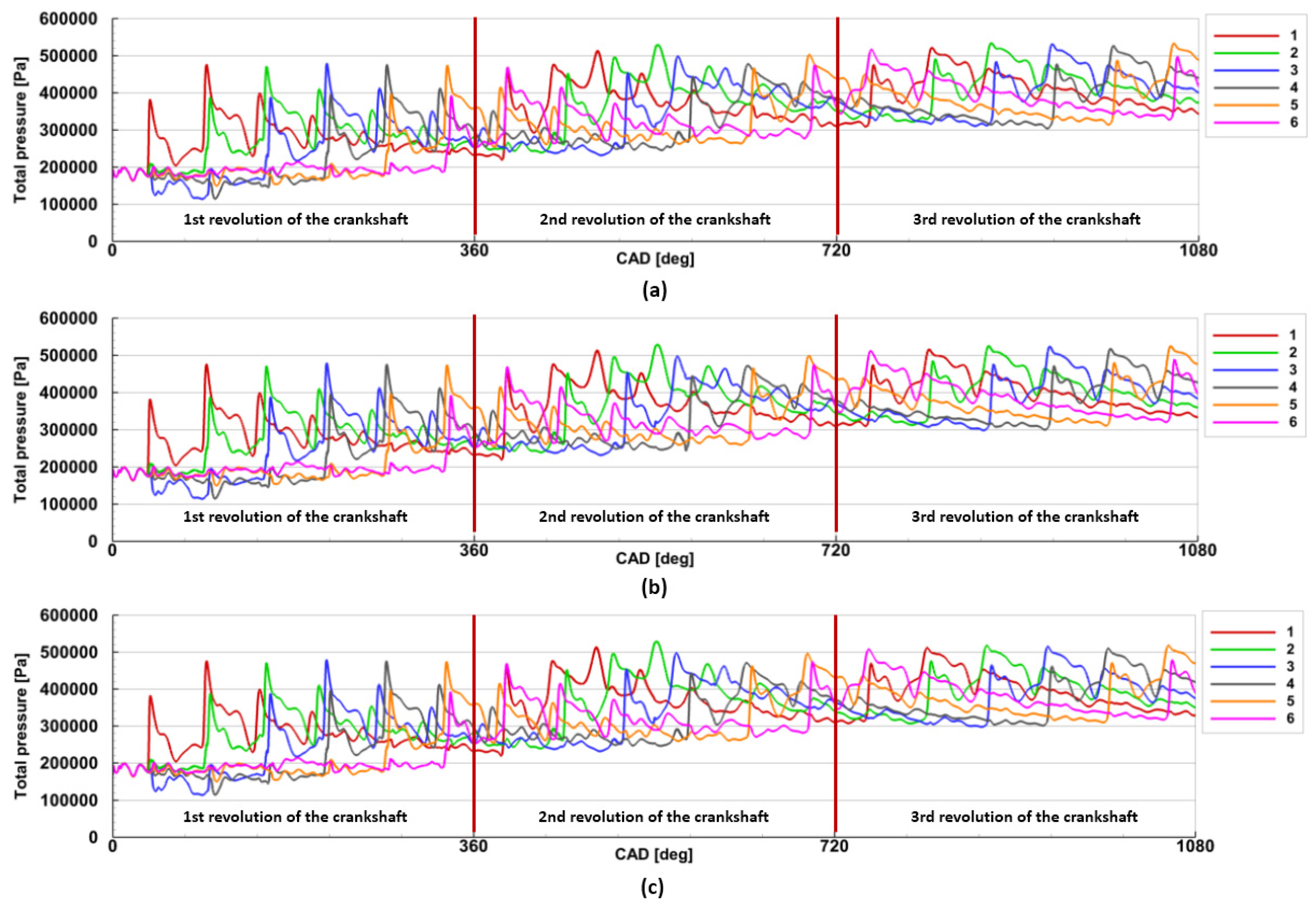
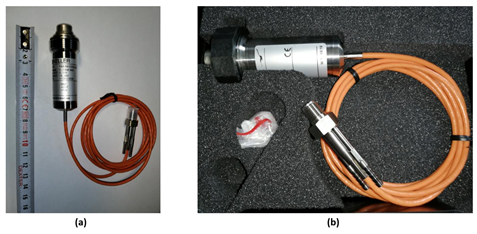
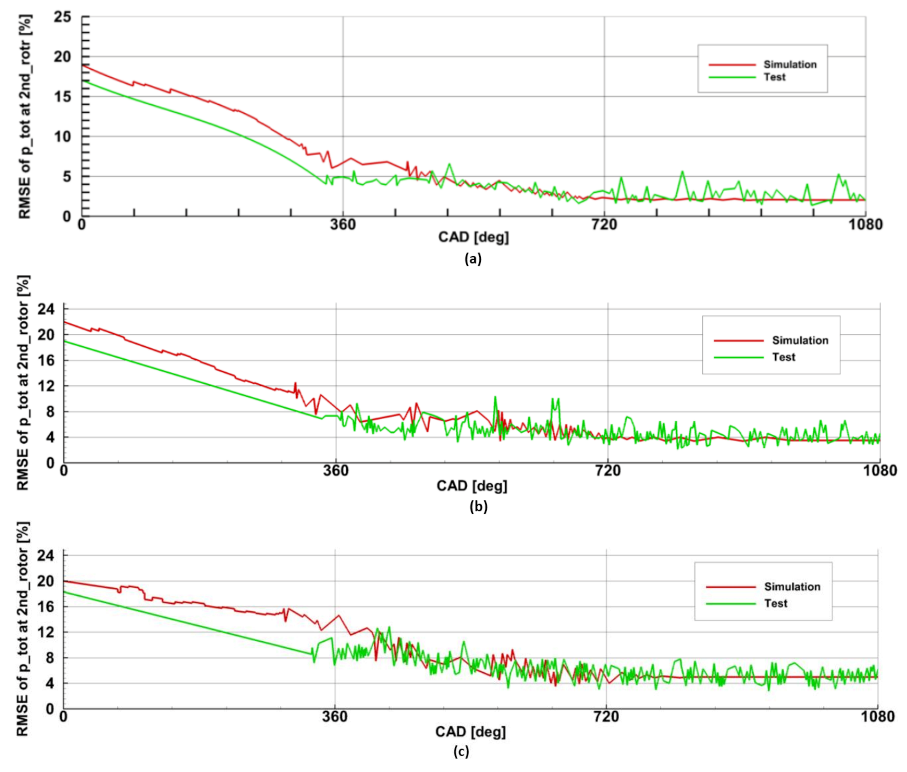
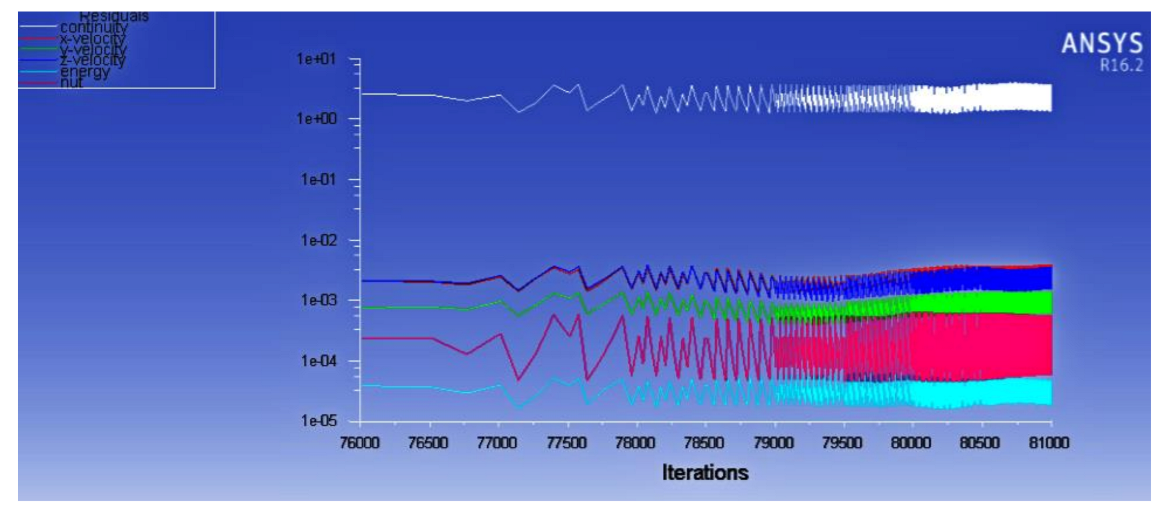
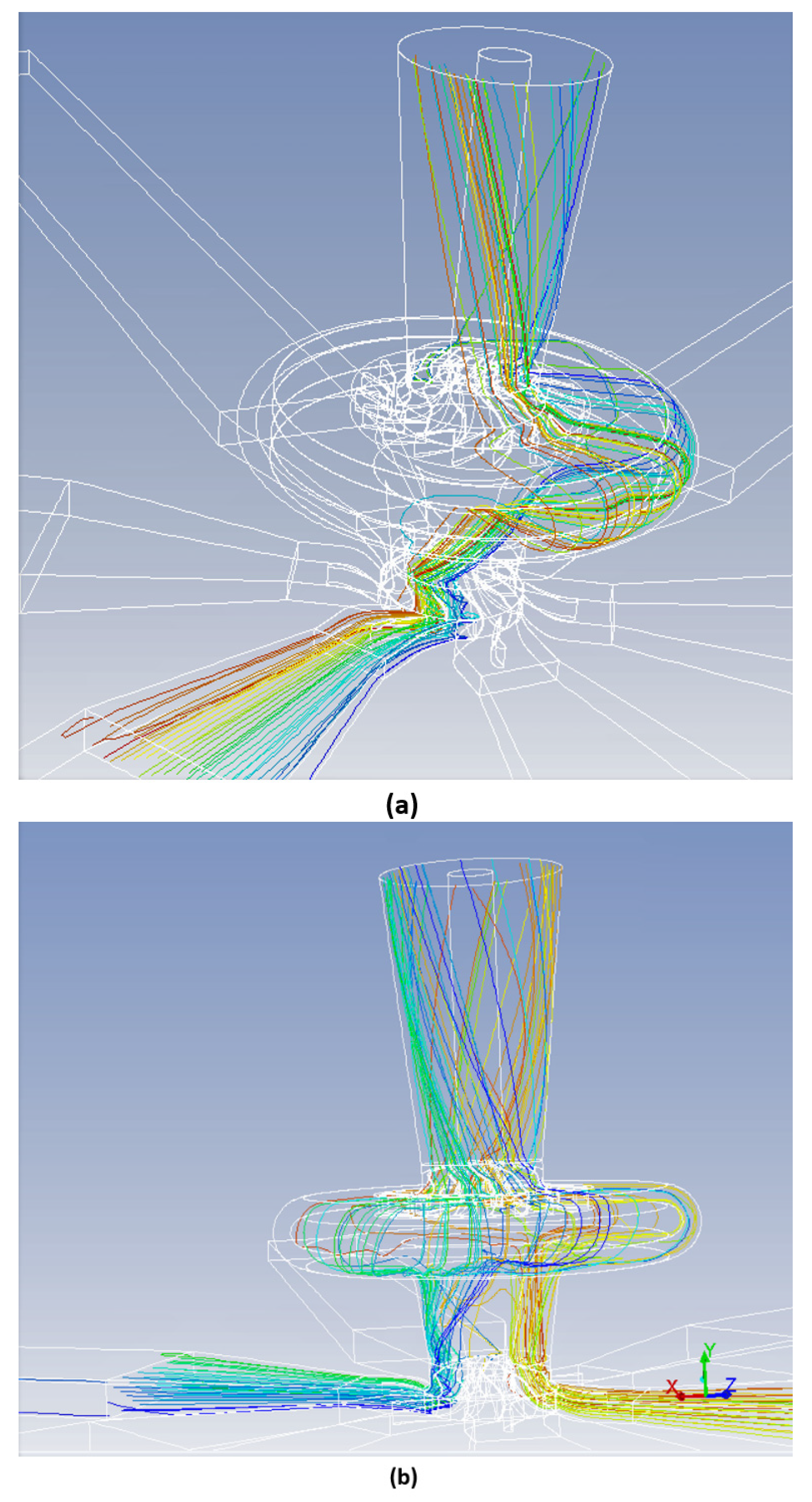
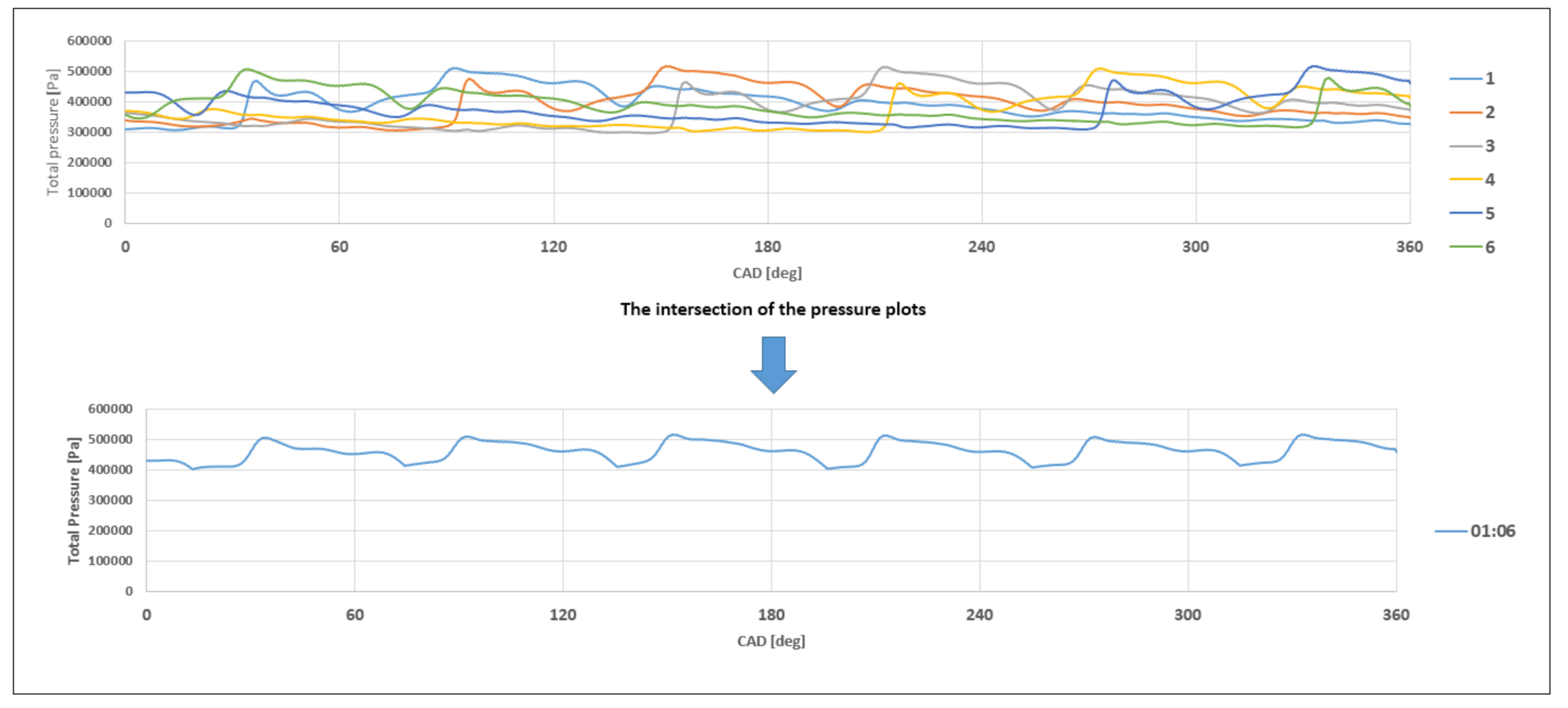

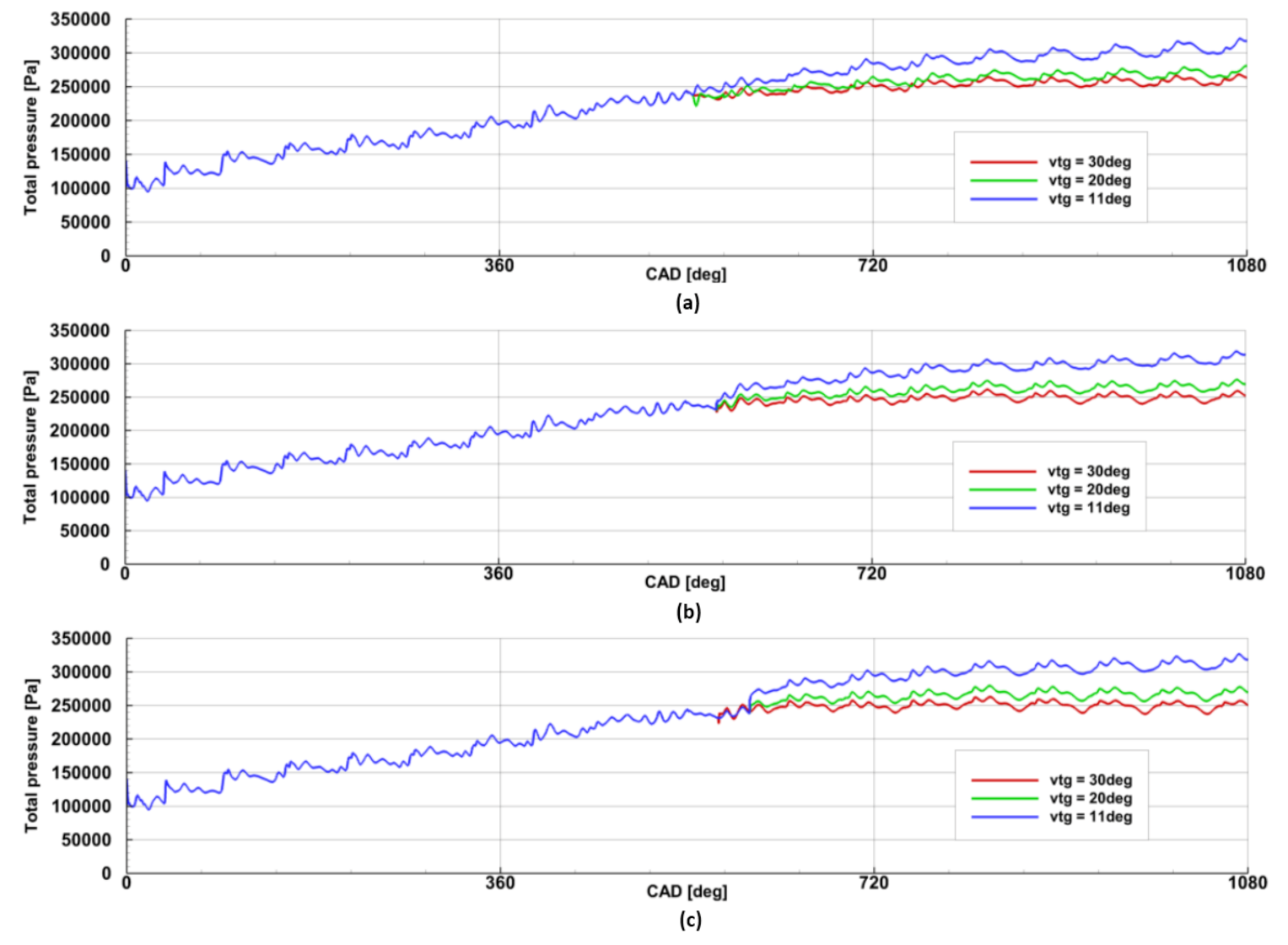

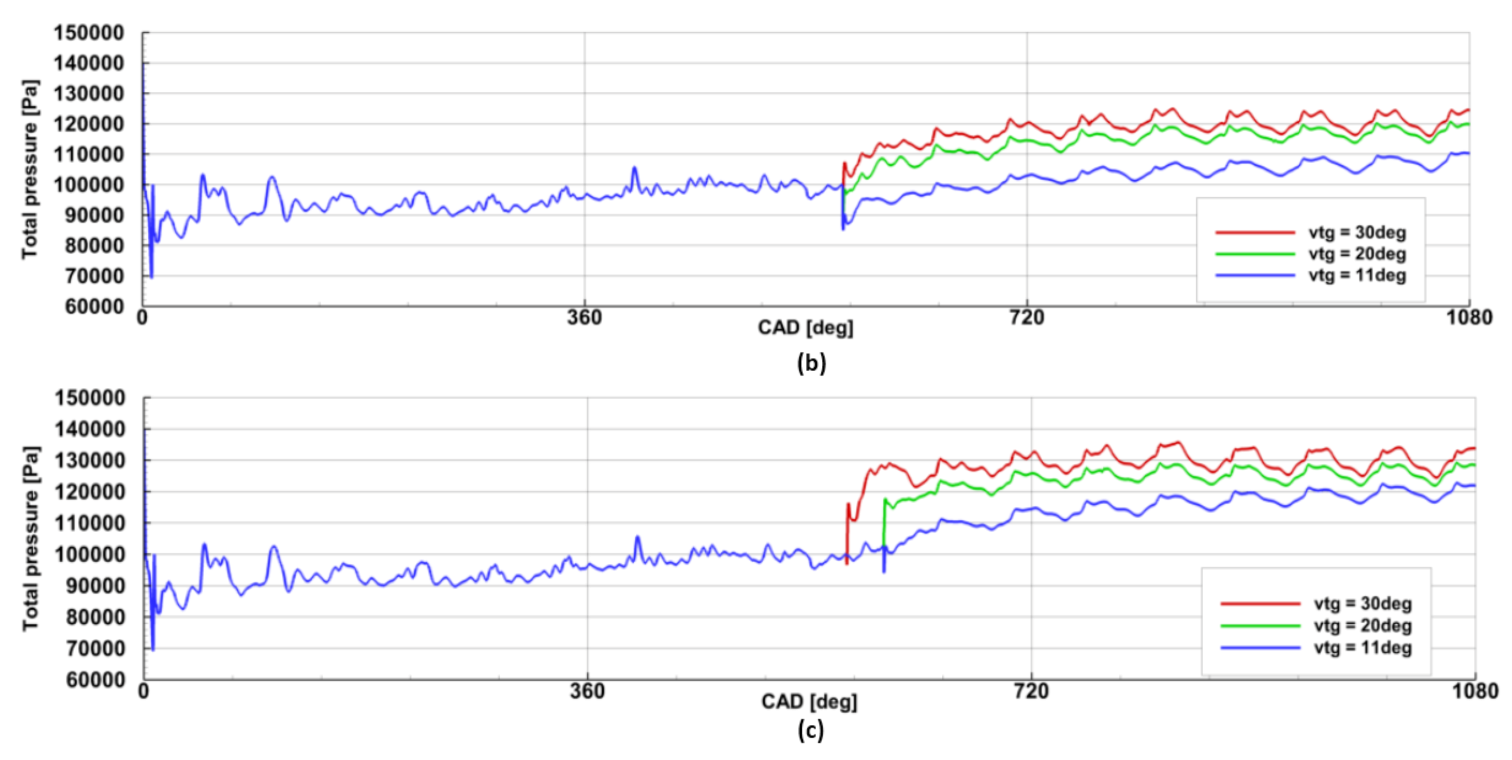


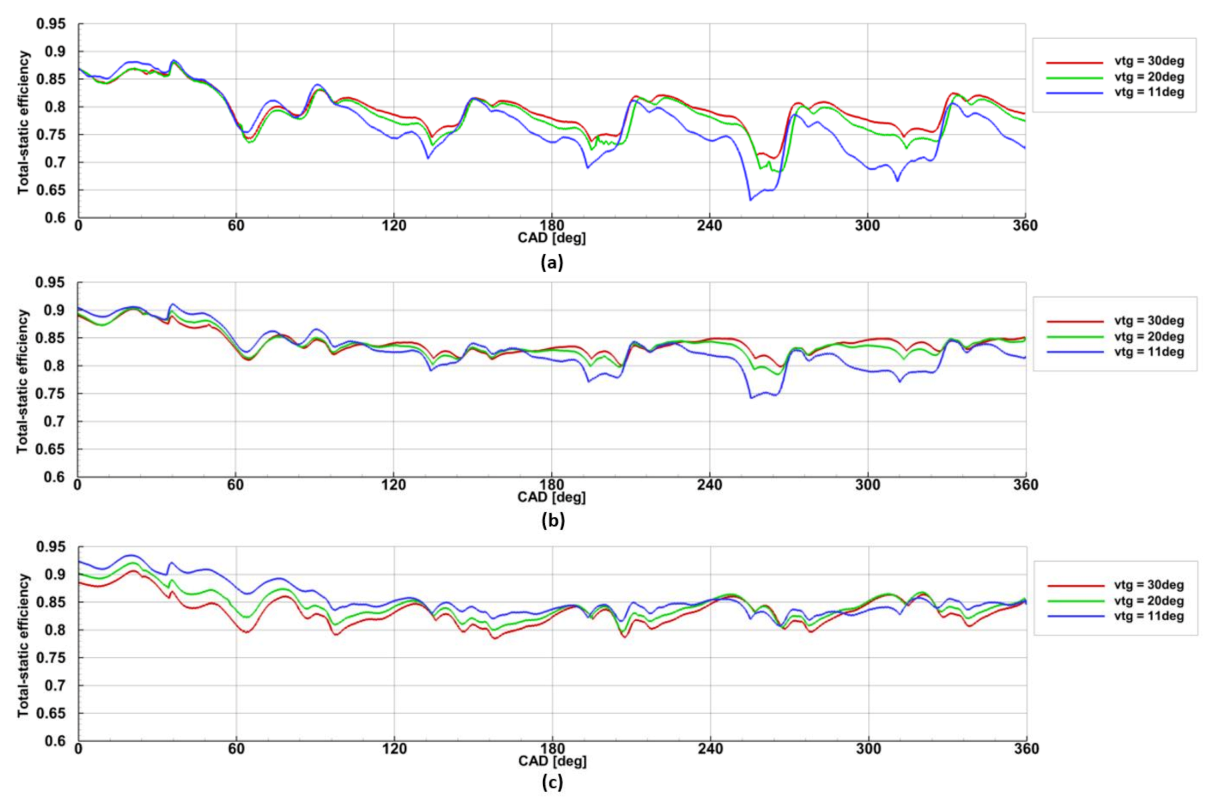

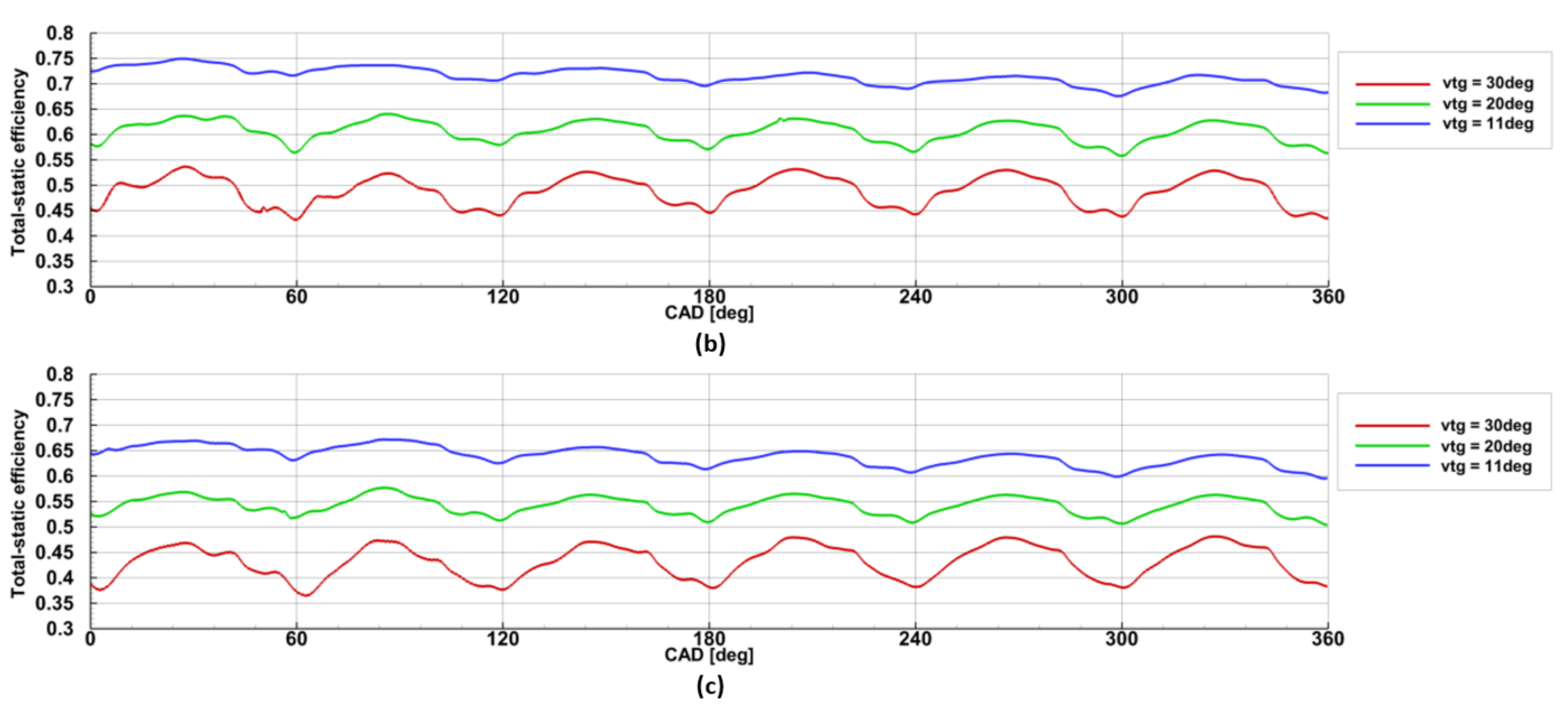

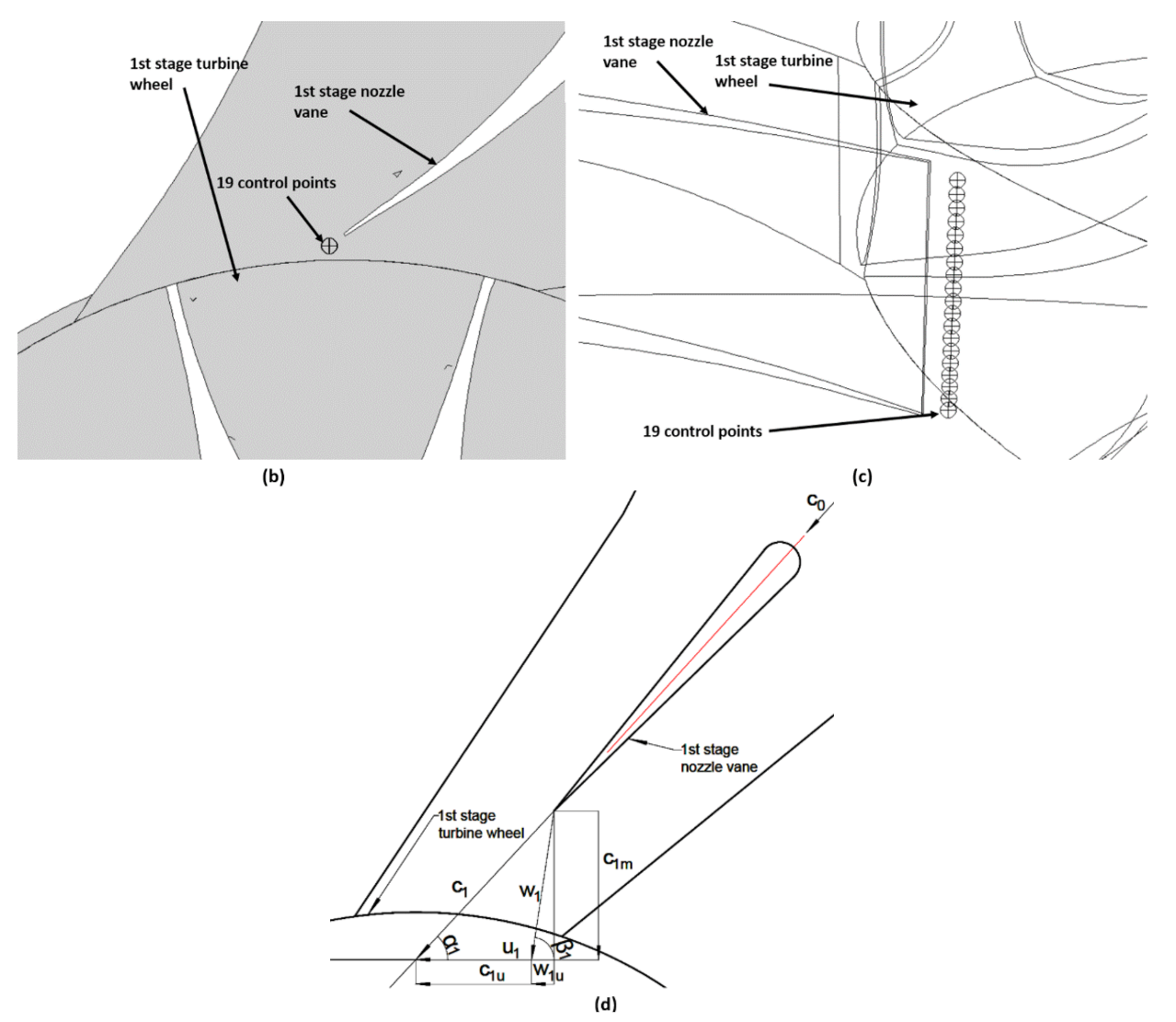
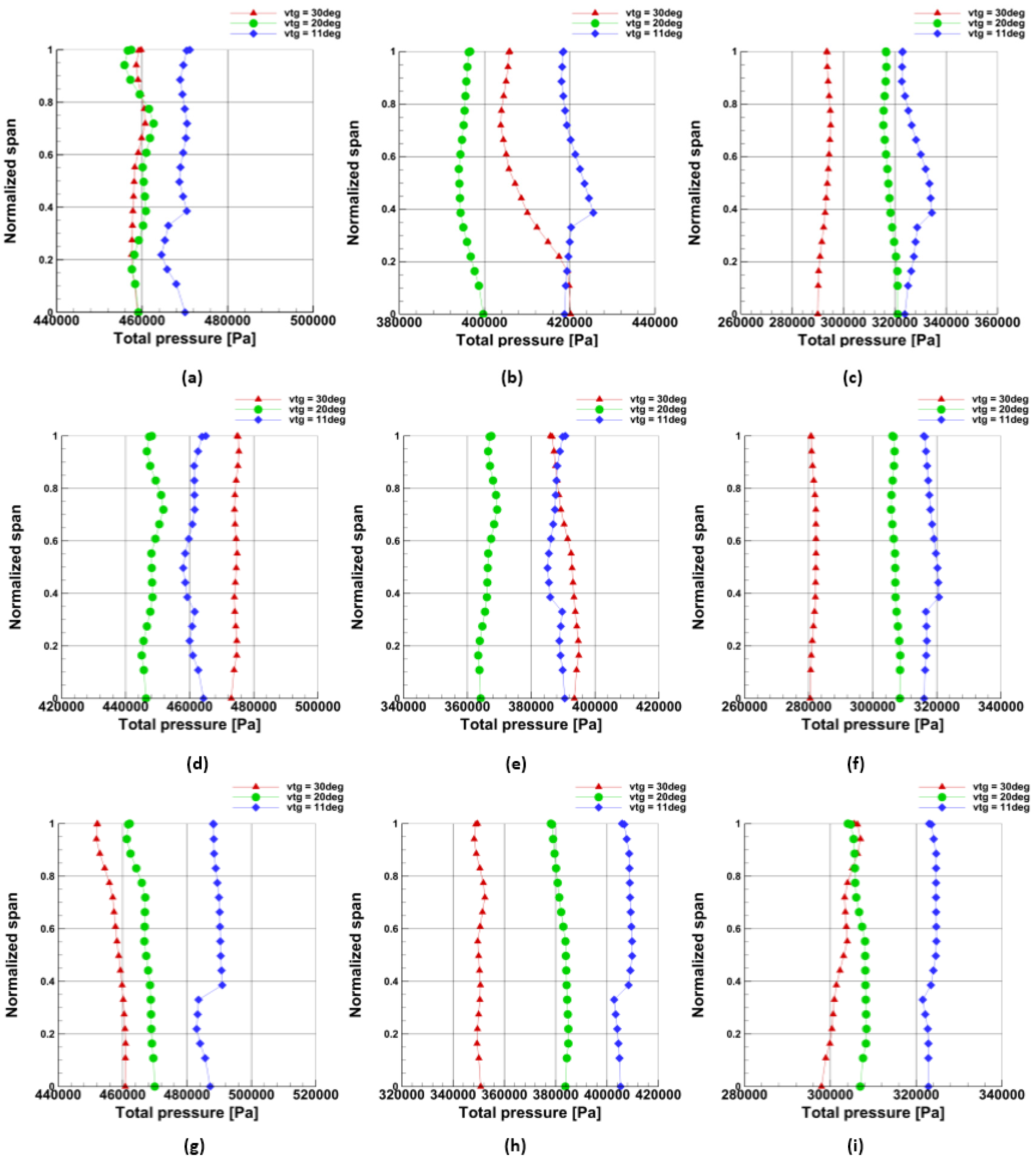
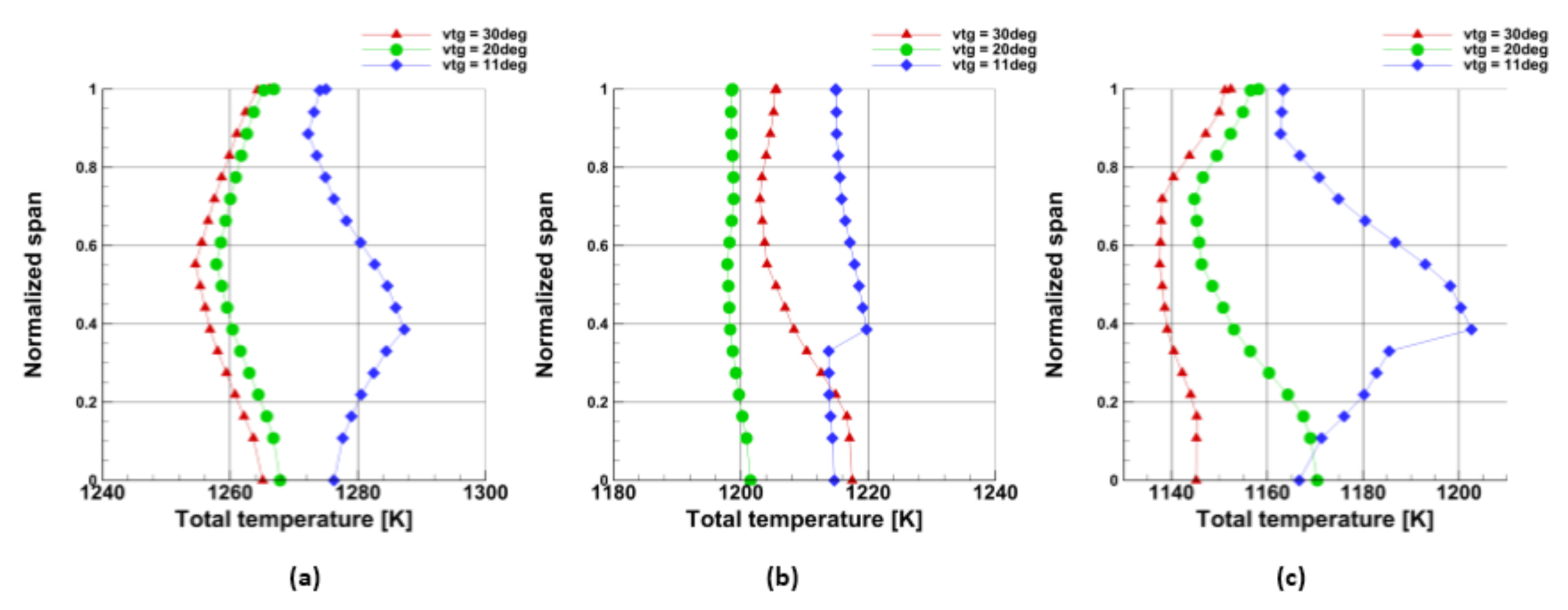
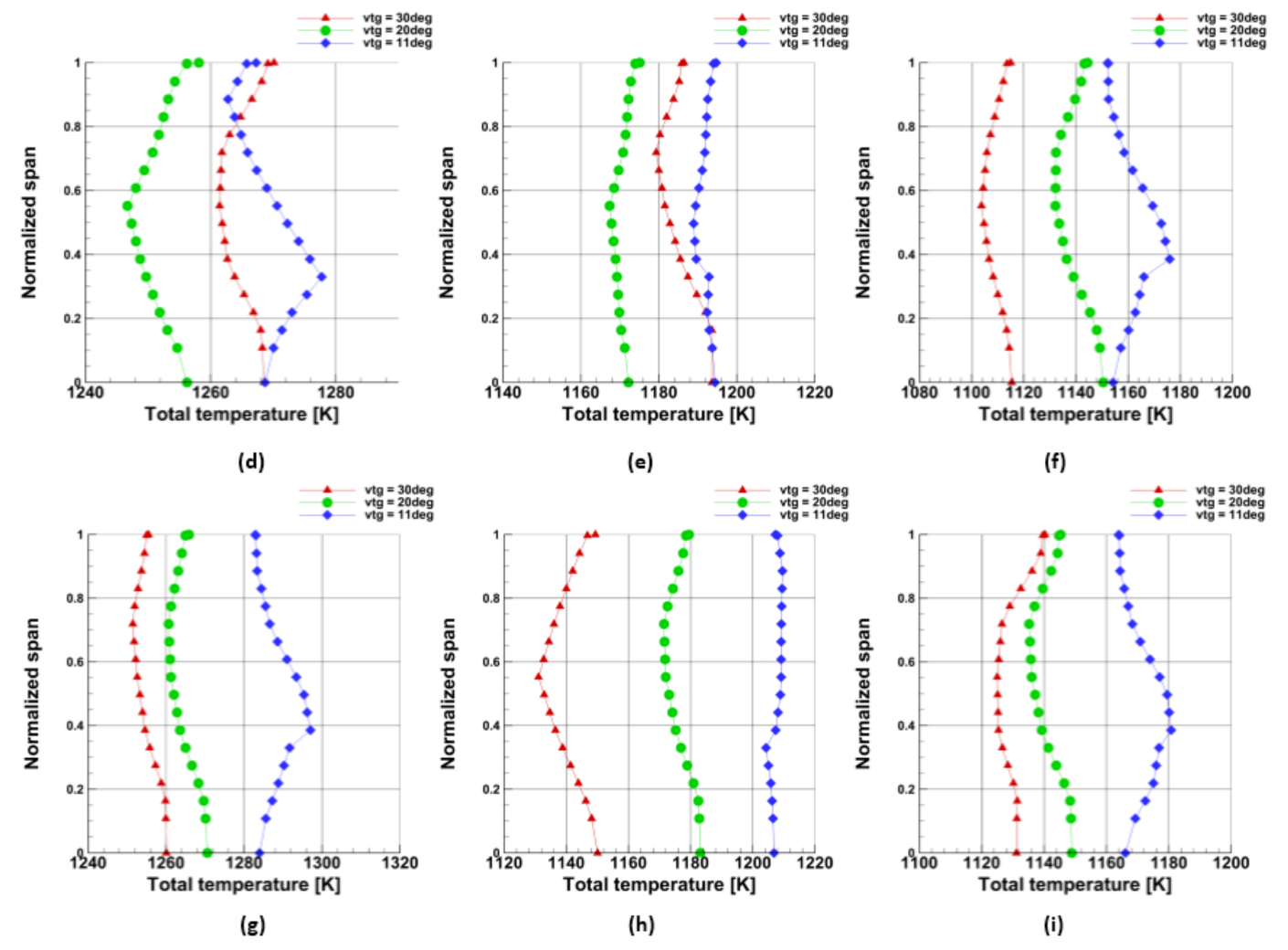
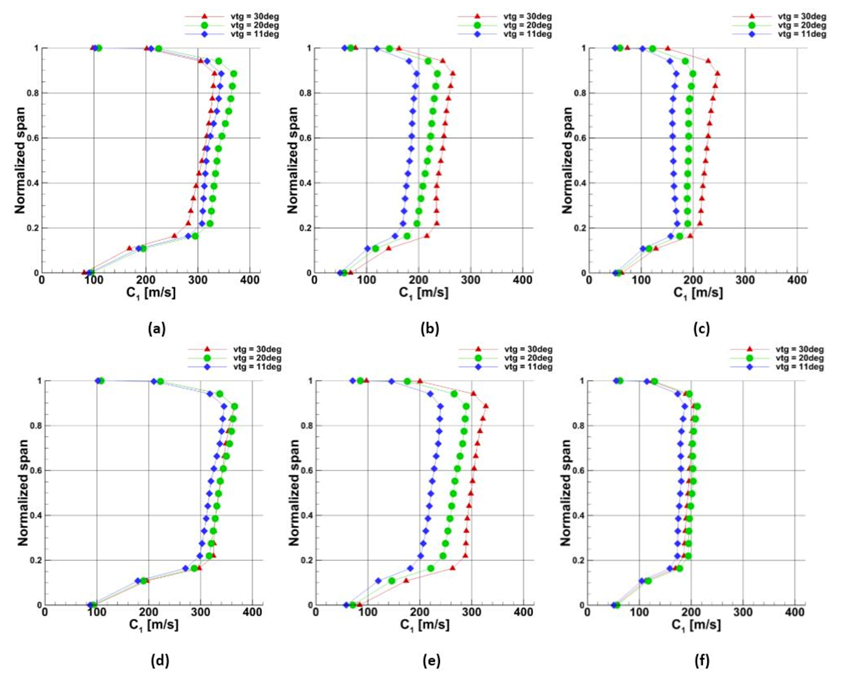
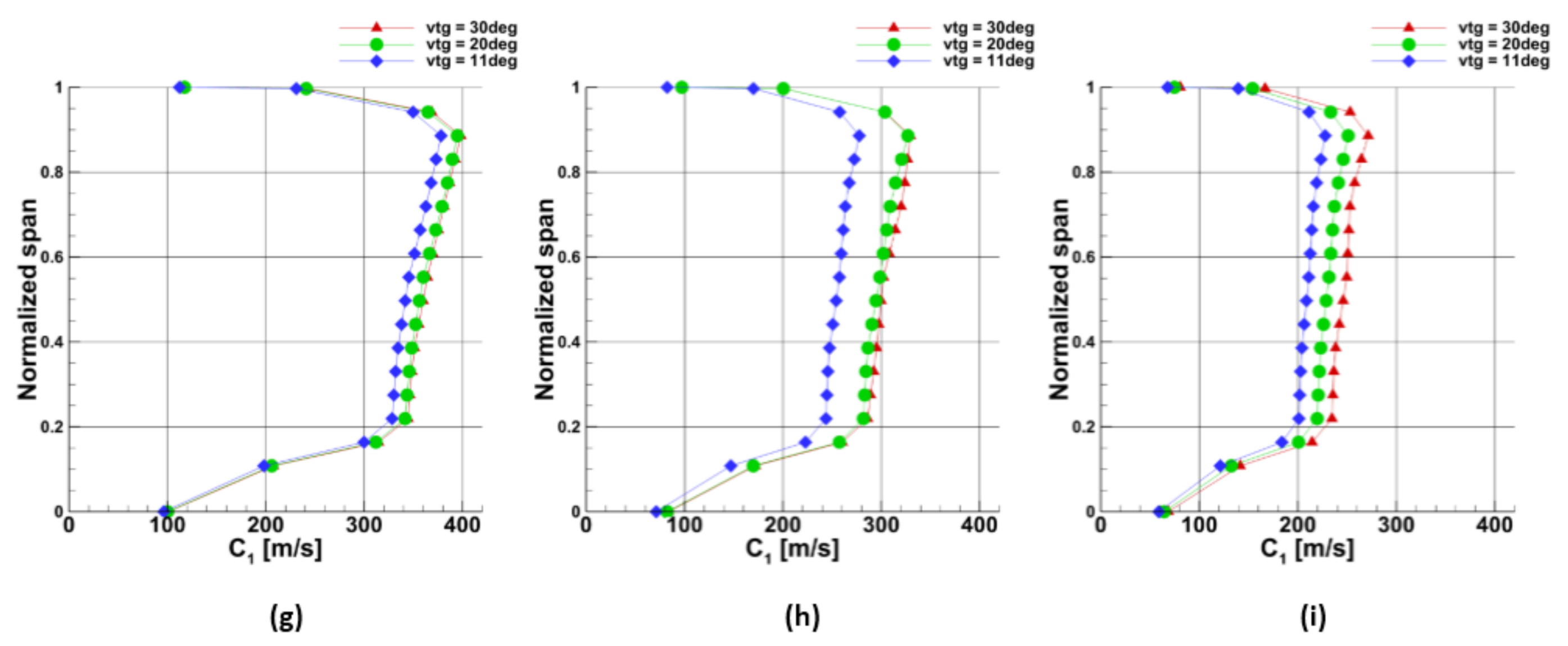
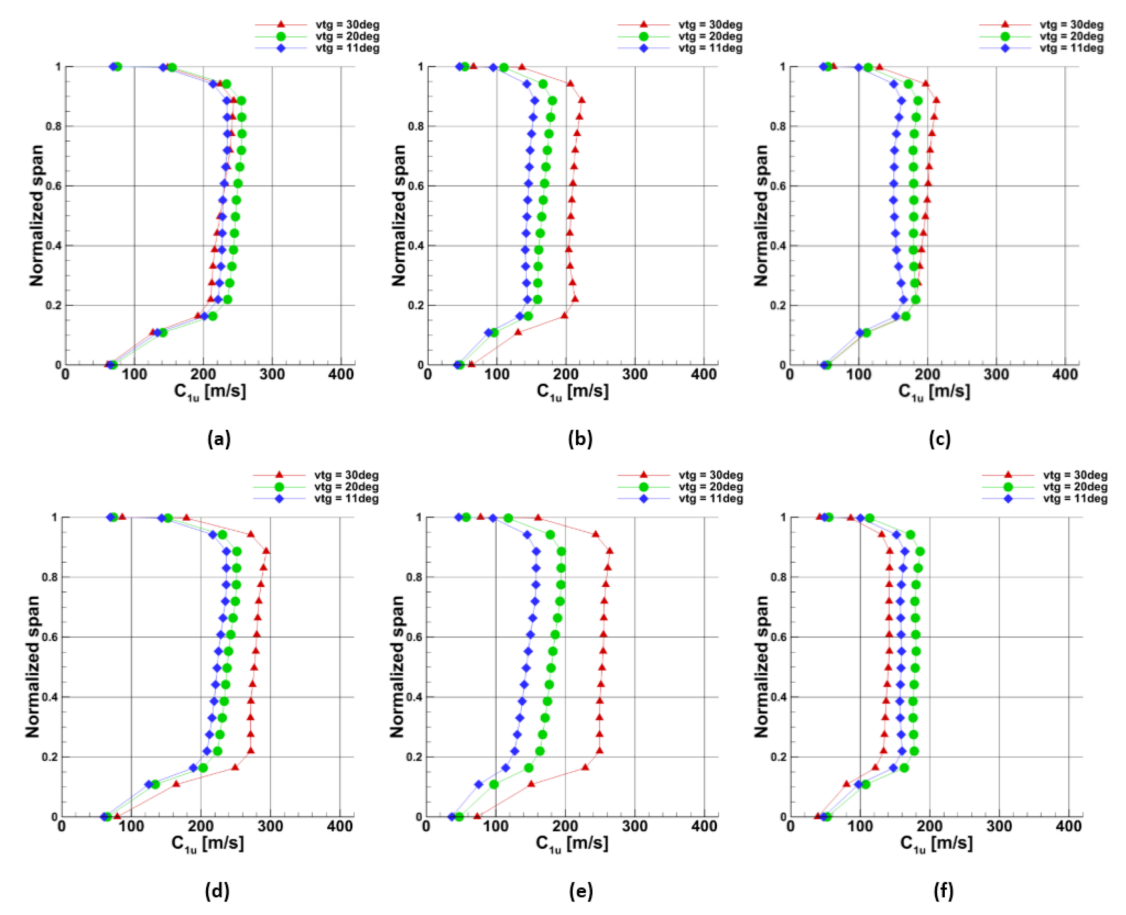
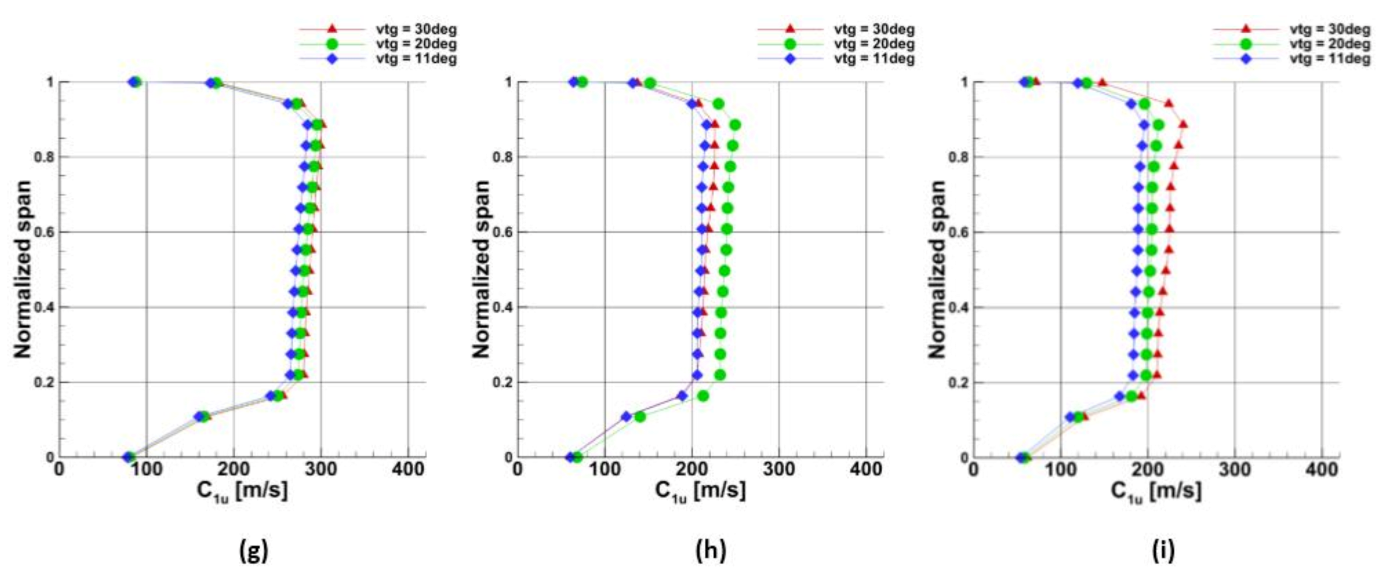
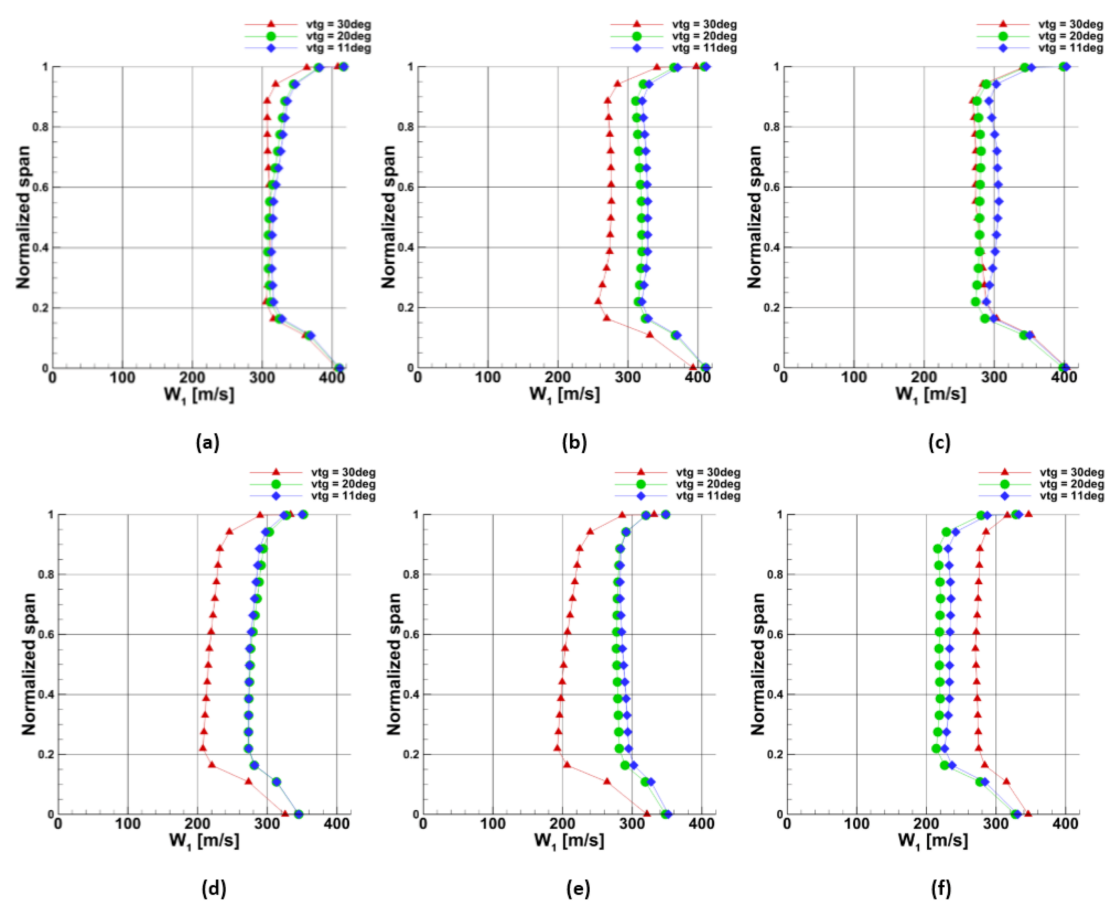
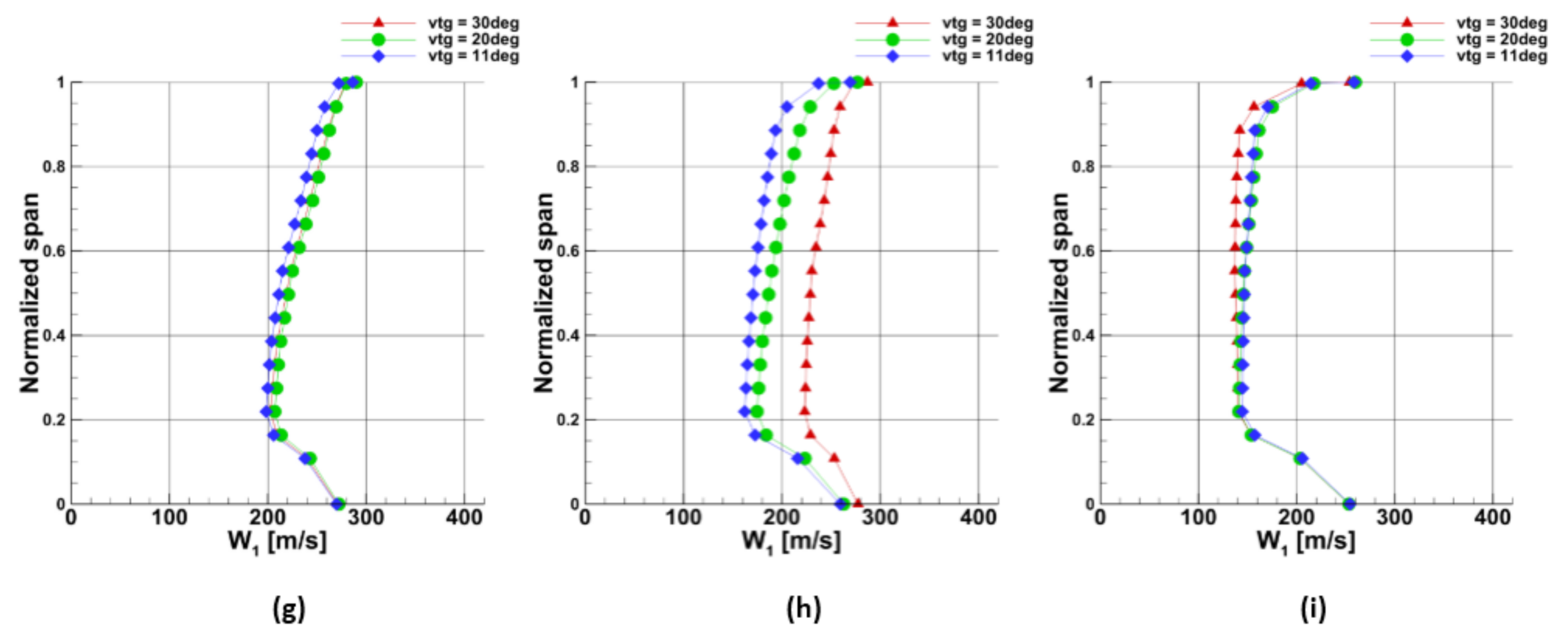



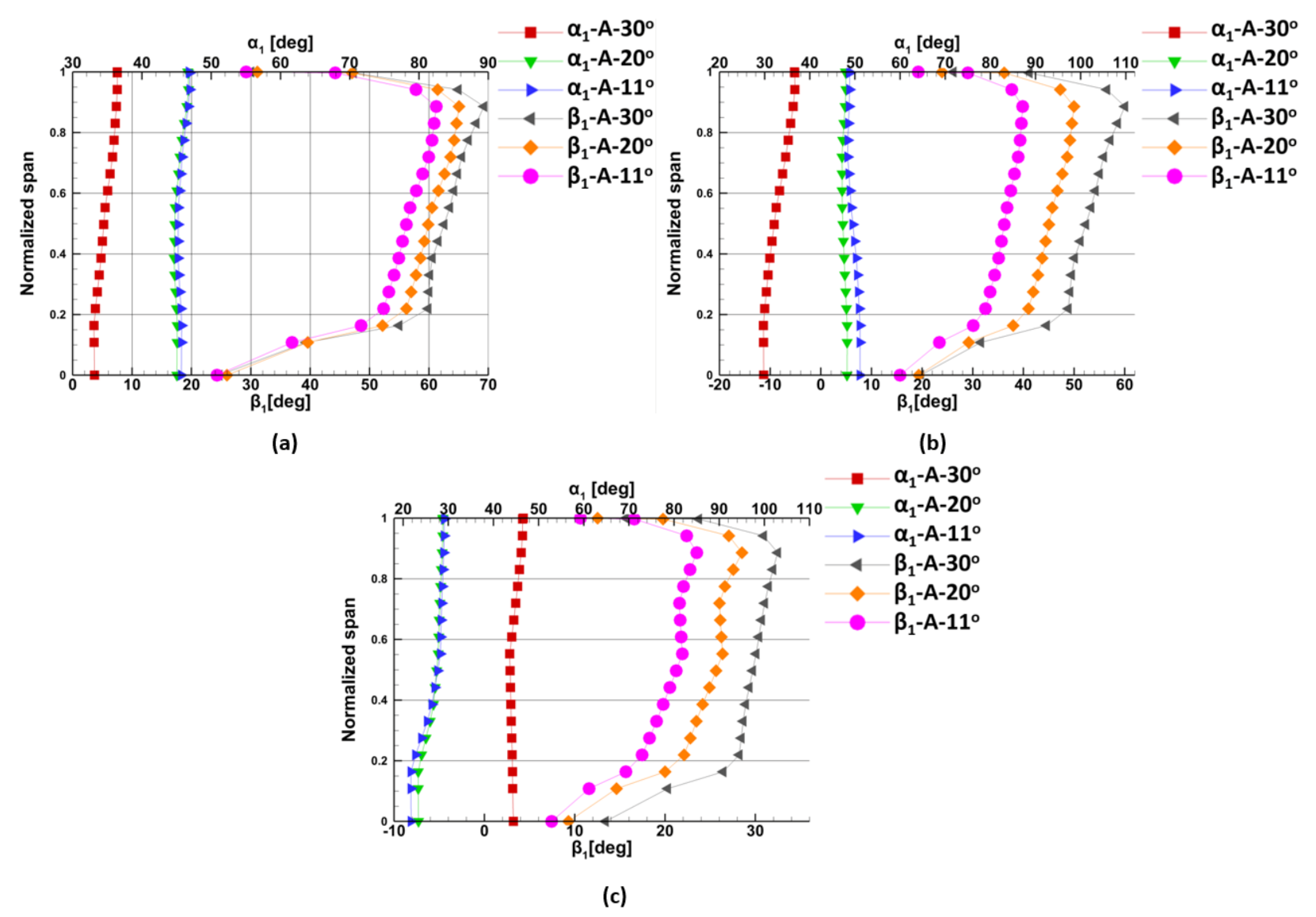
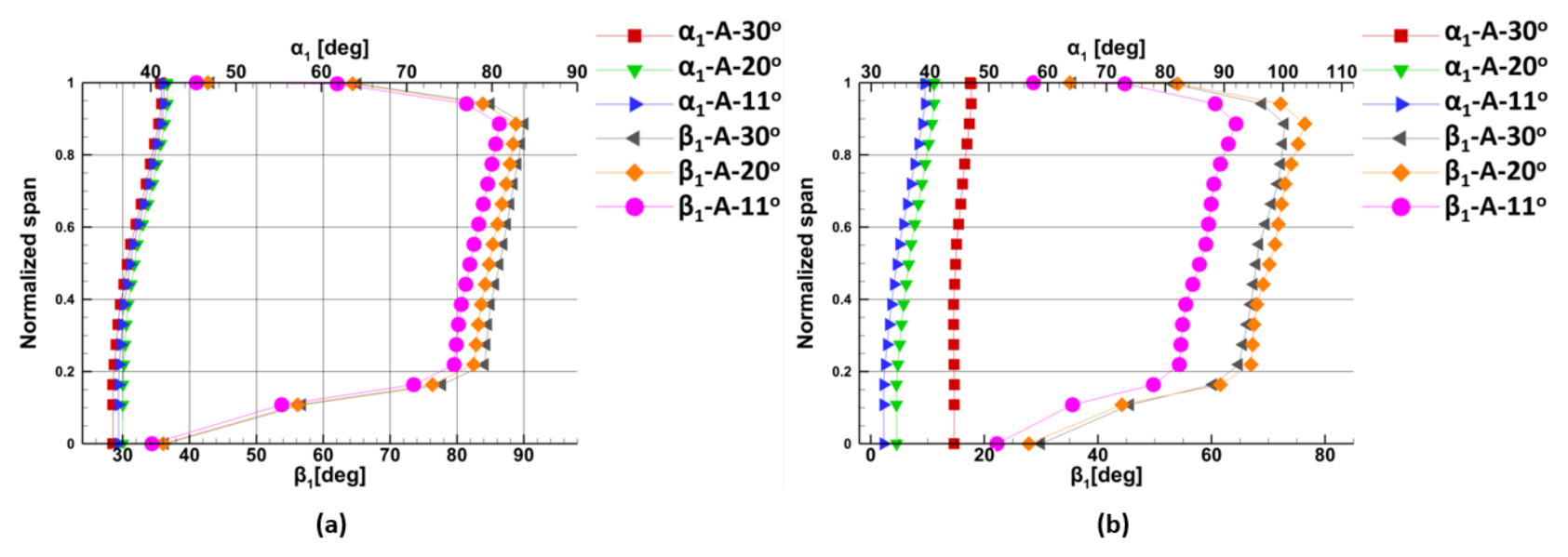
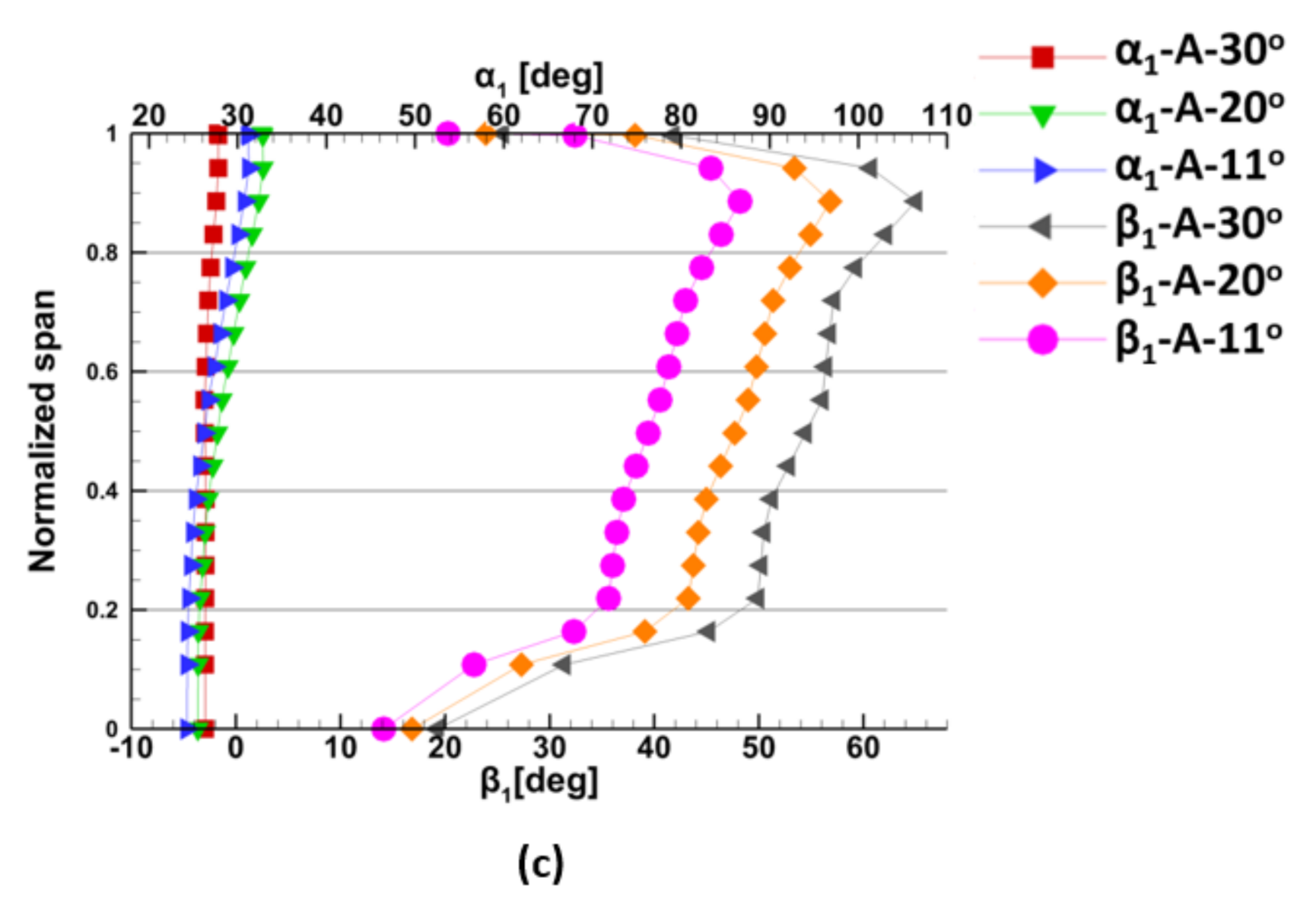
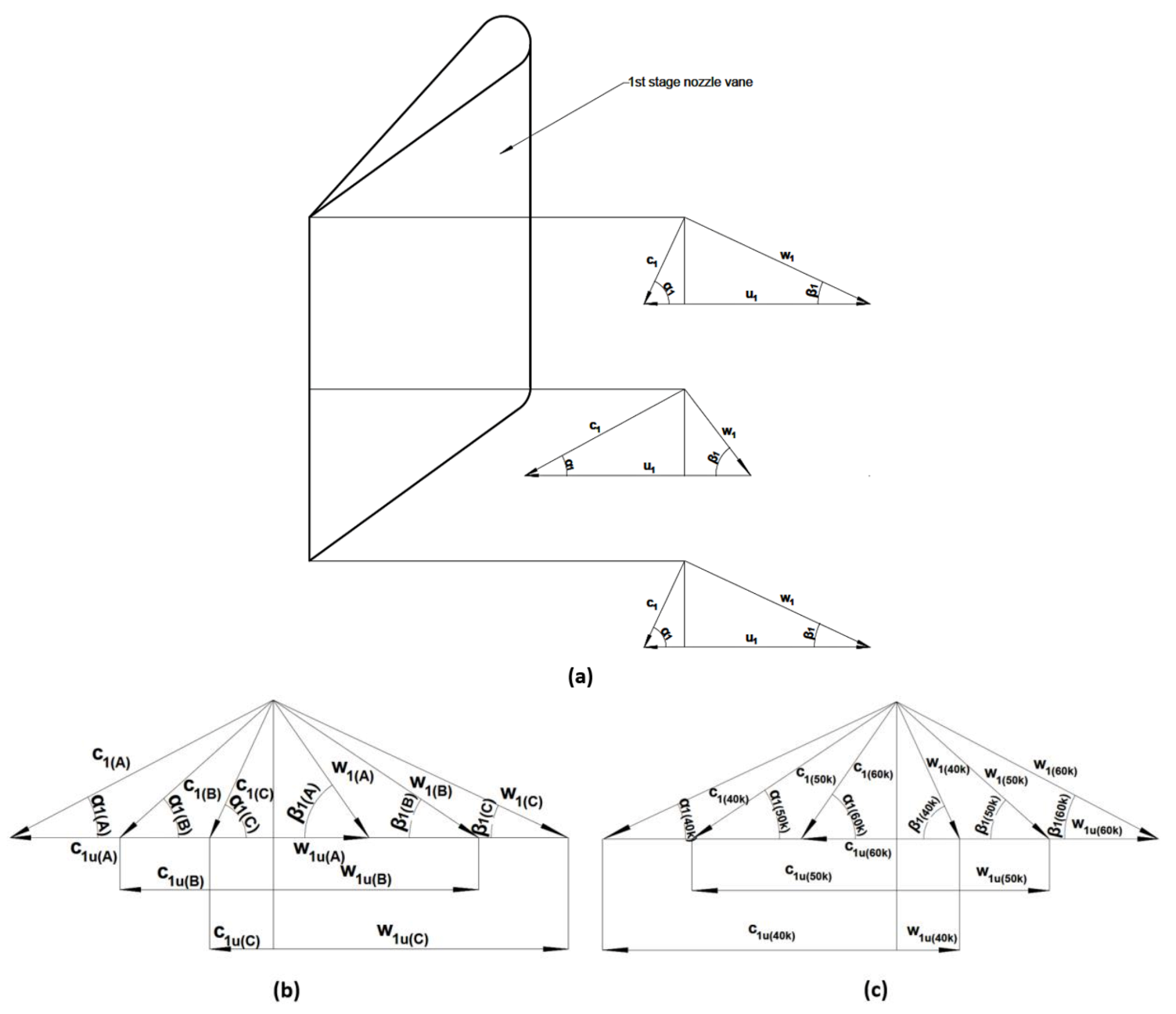
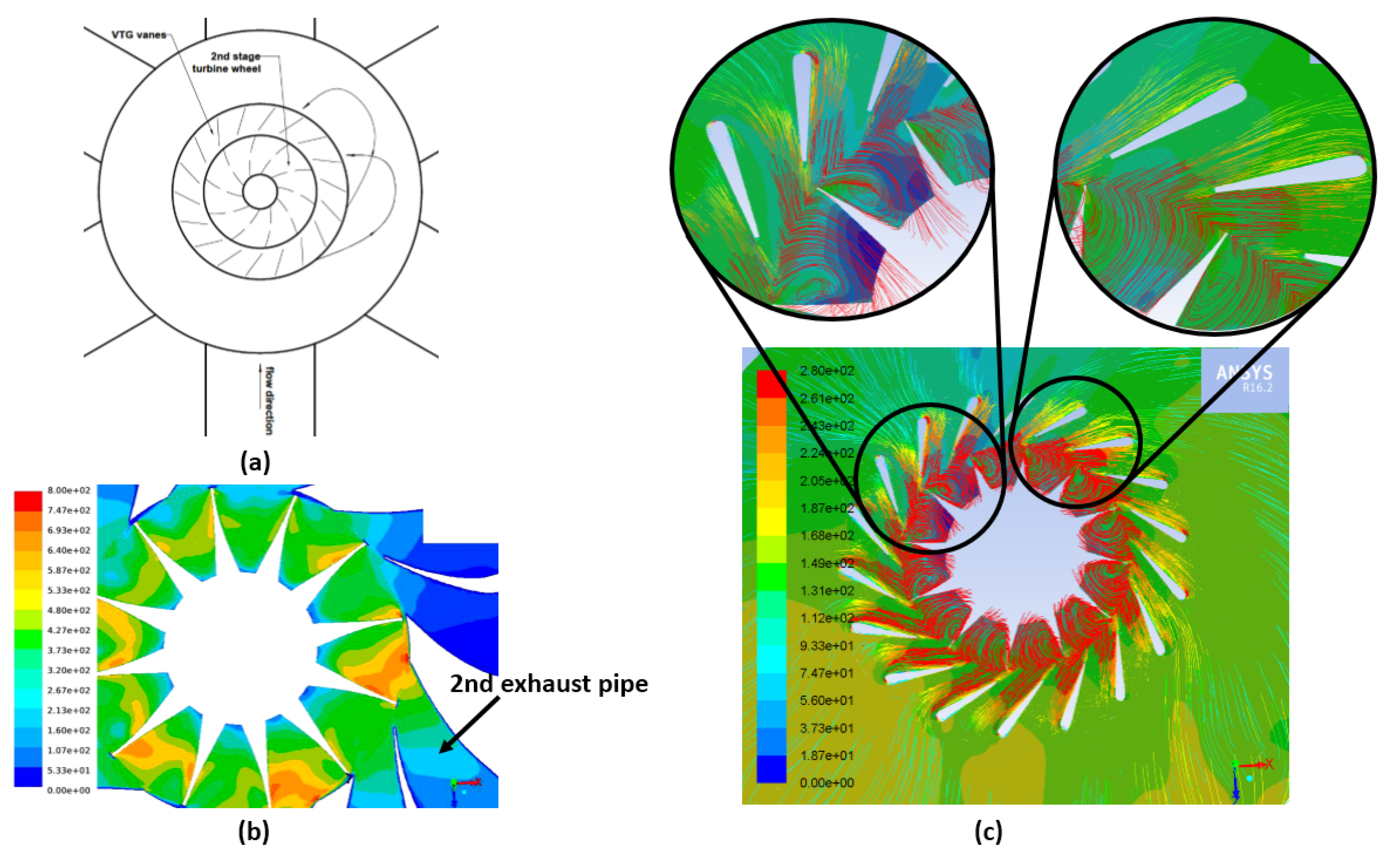
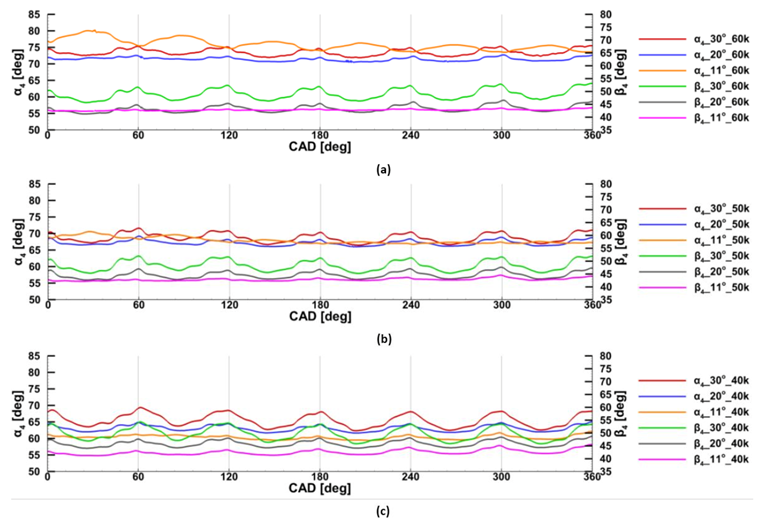

| B&W K44 Turbine Wheel | |
|---|---|
| Type | Radial inflow |
| Number of blades | 12 |
| Inlet diameter (mm) | 120 |
| Outlet diameter (mm) | 140 |
| Inlet blade height (mm) | 125 |
| Outlet blade height (mm) | 30 |
| Engine Parameters | |
|---|---|
| Number of cylinders | |
| Type | 2-stroke |
| Rotational speed | 1500 |
| Cylinder bore (mm) | 115 |
| Cylinder Stroke (mm) | 195.2 |
| Displacement (cm3) | 24,000 |
| Crankshaft angle step (deg) | 0.1 |
| Inlet Boundary Conditions | |
|---|---|
| Type | Mass-flow-inlet |
| Mass flow rate (kg/s) | |
| Total temperature (K) | 1100 |
| Total pressure (Pa) | 240,000.0 |
| Outlet Boundary Conditions | |
| Type | Pressure-outlet |
| Outlet pressure (Pa) | 100,000 |
| Outlet temperature (K) | 500 |
| Computer Parameters | |
|---|---|
| Number of cores | 4 |
| Processor type | Inlet Core i7 |
| Random-access memory (Gb) | 32 |
| Graphics processor unit memory (Gb) | 0.512 |
| Domain | Number of Elements |
|---|---|
| Exhaust pipe (×6) | 43,200 |
| First-stage nozzle vane (×6) | 18,036 |
| Tip clearance gap (×6) | 540 |
| 1st stage rotor | 1,340,000 |
| Inter-stage pipes | 168,018 |
| VTG vanes | 711,000 |
| 2nd stage rotor | 1,340,000 |
| Outlet | 374,850 |
Publisher’s Note: MDPI stays neutral with regard to jurisdictional claims in published maps and institutional affiliations. |
© 2021 by the authors. Licensee MDPI, Basel, Switzerland. This article is an open access article distributed under the terms and conditions of the Creative Commons Attribution (CC BY) license (https://creativecommons.org/licenses/by/4.0/).
Share and Cite
Kozak, D.; Mazuro, P.; Teodorczyk, A. Numerical Simulation of Two-Stage Variable Geometry Turbine. Energies 2021, 14, 5349. https://doi.org/10.3390/en14175349
Kozak D, Mazuro P, Teodorczyk A. Numerical Simulation of Two-Stage Variable Geometry Turbine. Energies. 2021; 14(17):5349. https://doi.org/10.3390/en14175349
Chicago/Turabian StyleKozak, Dariusz, Paweł Mazuro, and Andrzej Teodorczyk. 2021. "Numerical Simulation of Two-Stage Variable Geometry Turbine" Energies 14, no. 17: 5349. https://doi.org/10.3390/en14175349
APA StyleKozak, D., Mazuro, P., & Teodorczyk, A. (2021). Numerical Simulation of Two-Stage Variable Geometry Turbine. Energies, 14(17), 5349. https://doi.org/10.3390/en14175349







